PRINTER FRIENDLY PDF
EPUB
AUDIOBOOK
As any student of naval and maritime history knows, sea power is the ability of a nation to use and control the sea and to prevent an opponent from using it. Merely having a fleet is not enough; any nation that wishes to control the sea must be able to project its power in real or concrete form. According to current U.S. Navy doctrine, power projection in and from the sea includes a broad spectrum of offensive operations to destroy enemy forces or to prevent enemy forces from approaching within range of friendly forces. History shows that there are generally three ways to accomplish this goal: amphibious assault, attack of targets ashore, or support of sea control operations.1 The United States is, of course, the world’s leading maritime power; a key component of its maritime power projection capability is the U.S. Navy and Marine Corps’ Amphibious Ready Group/ Marine Expeditionary Unit (ARG/MEU), a force that is increasingly relevant in today’s complex operating environment. The way in which the ARG/MEU concept evolved is an excellent example of how the Marine Corps has successfully adapted throughout its history in response to changing political and military circumstances.
Whenever a Marine Air-Ground Task Force (MAGTF) consisting of a battalion landing team, composite air squadron, and combat logistics battalion is embarked aboard a Navy Amphibious Squadron (PhibRon), an ARG/MEU is created. Up to three can operate continuously in the areas of responsibility assigned to the Geographic Combatant Commands (GCC), including the Pacific, Central, African, and European commands. These versatile units provide the president of the United States, acting in his capacity as the commander in chief of the U.S. Armed Services, and the GCC commanders with credible deterrence and response capability across the range of military operations. ARG/MEUs serve as forward-deployed, flexible sea-based MAGTFs—an afloat-ready force—a force capable of conducting amphibious operations to respond to a crisis, conduct limited contingency operations, introduce follow-on forces, or support designated special operations forces at a moment’s notice. ARG/MEUs are characterized by their sea-based forward presence, expeditionary nature, ability to plan for and respond to crises, combined arms integration, and interoperability with joint, combined, and special operations forces in support of theater requirements.2 However, the ARG/MEU concept did not simply spring into existence overnight. Its inception as an afloat-ready force dates back to the late 1800s and reflects a confluence of three factors: policy (i.e., the political-military need for afloat-ready forces by the U.S. government, and by extension, the U.S. Navy); the maturation of the Marine Corps’ expeditionary doctrine that featured the ARG/MEU as its centerpiece; and the technological development of aircraft and amphibious assault shipping that enabled the MAGTF to operate in its maritime environment. This article will lay out the historical milestones of this concept, including its early origins, and show how policy, doctrine, and technology have contributed to the evolution over the past 118 years of the force deployed around the globe today.
Historical Origins of the Afloat-Ready Force
Since its inception in 1775, the U.S. Marine Corps has contributed a detachment of Marines, numbering anywhere from 6 to 60 Marines, to nearly every major warship’s complement, from sloop to frigate, until the turn of the nineteenth century. Serving as “naval infantry” when needed, as marksmen in the “fighting tops” of sailing ships during sea battles, and as the ship’s guard, they also were ready to enforce shipboard discipline when necessary. Should a landing party be ordered to go ashore to fight or land for less warlike purposes as part of a naval expedition, Marines would make up a portion of the party, but would usually be outnumbered by Navy bluejackets, who were part of the ship’s normal complement.
As a rule, large numbers of Marines would not normally be embarked on a Navy ship, especially in cases where a fleet or flotilla might sail on missions lasting weeks or even months. There was simply no reason for them to do so, unless embarked on a troopship where they would be landed as part of a land campaign led by the U.S. Army. Exceptions were made should a large-scale amphibious landing be contemplated, such as at Veracruz, Mexico, in 1847, or Fort Fisher, North Carolina, in 1864, but Marines did not ordinarily embark to serve as a fleet’s contingency landing force to be landed if and when a commodore saw fit. There was simply no room aboard contemporary warships for anything larger than a detachment of up to 60 men.
Despite this record, at least one naval officer during this period advanced the idea of having an embarked landing force sailing with the fleet at all times. The officer, Navy Commander Bowman H. McCalla, had recorded his suggestion in an after action report about the U.S. Navy and Marine Corps expedition of April 1885 to the Isthmus of Panama, then still part of Columbia. Noting how readily the brigade of Marines restored peace and prevented an insurrection once ashore, McCalla wrote that “in future naval operations an additional number of seamen and marines, organized in naval brigades, will be carried in transports accompanying the battle ships.” Though the seeds of an idea had been sown, the Navy Department did not concur and would continue to adhere to existing practice of forming ad hoc landing forces when needed.3
That policy changed in 1898, when the United States declared war on Spain. Confronted by a maritime enemy with naval and land forces stationed around the globe defending various overseas colonies, such as Cuba, Puerto Rico, and the Philippines, the U.S. Navy was challenged by the enormous distances involved in simply closing the distance to do battle. Another aspect of naval warfare that had changed since the Marine Corps’ inception was the introduction of steam-powered warships, which had completely replaced wooden sailing ships by the end of the nineteenth century. Instead of being driven by inexhaustible wind power, ships were now dependent upon coal to fire their steam plants, which enabled them to travel faster and at a steadier pace than with sail power. However, steel-hulled steam-powered warships could not carry enough coal, the fuel of choice, to travel 8,000 miles or more to reach some of Spain’s far-flung possessions, where they presumably would do battle with the Spanish fleet once they arrived. Therefore, coaling stations and advanced bases located along the way were necessary and in fact became of strategic importance to the Navy.
While ships could and often did take on coal at sea, this was a slow and hazardous process that exposed a warship to danger while it had come to a complete stop and “hove to” alongside a fleet collier, unlike in today’s Navy, where underway replenishment is a common procedure. A coaling station in a protected harbor or port was thought to be far more preferable. However, a protected harbor would most likely have to be taken from the enemy, who might be using it for the same purpose. While, in theory, sailors could (and occasionally did) fight as part of a landing party, the only infantry the Navy had of any strength was the fleet’s few embarked Marines who actually had trained for ground combat as their stock-in-trade. To be effective, such an expeditionary landing force would have to be at least of battalion size (several hundred men), including artillery, which could embark and remain on board as an afloat-ready battalion and land whenever the naval commander deemed the situation required boots on the ground (in modern parlance) or when U.S. foreign policy dictated that they land. And therein lies the true genesis of the fleet’s “ready reserve” force, the forerunner of today’s Amphibious Ready Group/Marine Expeditionary Unit.
Huntington’s Battalion
The Marine Corps’ first ready reserve force or afloat battalion was “Huntington’s Battalion,” which was activated for expeditionary service during the Spanish-American War on 16 April 1898. Composed of Marines recruited from nearly every shipyard and naval installation detachment on the East Coast of the United States, it was created by the Colonel Commandant of the Marine Corps, Colonel Charles C. Heywood, in anticipation that the Navy would ask for such a force, but without knowing exactly how, when, or where it would be employed. This ad hoc organization, known officially as the 1st Marine Battalion (Reinforced), consisted of 654 Marines and one Navy surgeon.
It was organized into five infantry companies and one artillery battery equipped with four 3-inch rapid-fire guns and a battery of four Colt-Browning M1895 machine guns.4 There was, of course, no aircraft to support this modest force, since the Wright brothers’ pioneering flight was still five years out. Having received no definite mission from the Navy’s Atlantic Fleet, the battalion commander, Lieutenant Colonel Robert W. Huntington, was ordered to have his men board the converted transport USS Panther (1889) in New York City on 22 April 1898. While underway, they learned that they were bound for the naval blockade of Cuba.
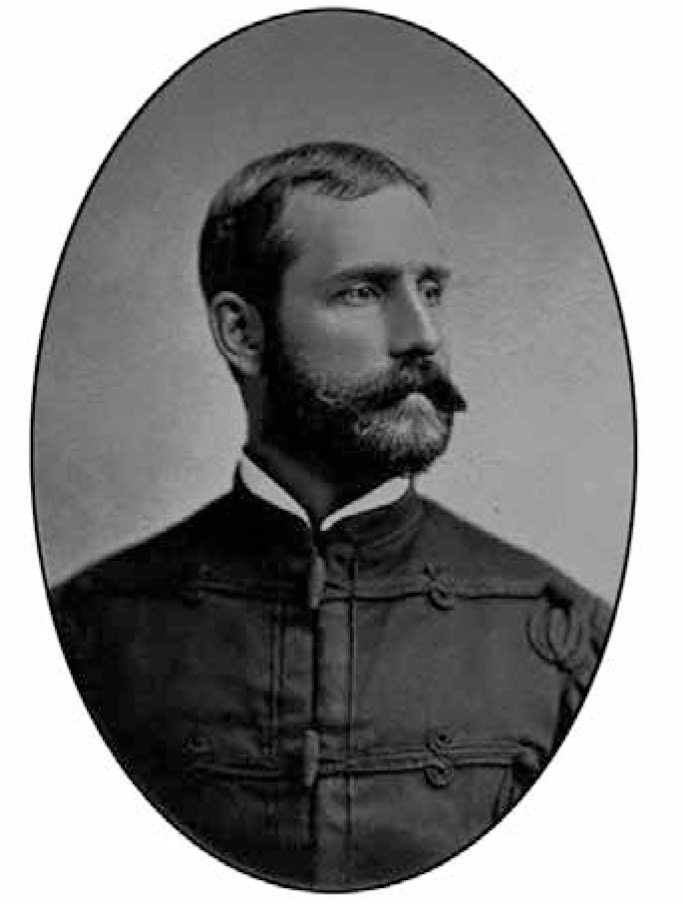
Col Robert W. Huntington as a major in the 1870s. Naval History and Heritage Command, NH48984
The Panther was hardly suited as an attack transport. It was old and crowded, having been purchased with the intent of carrying only half the number of Marines that were actually embarked. A former South American banana freighter, its hasty conversion to a troopship failed to address many of the amenities taken for granted today, such as adequate ventilation and heads (toilets) and galley (kitchen) spaces. Given the time constraints, it was the best the Navy could do. After nearly two months in limbo, half of the time being spent ashore at Key West, Florida, and the other half afloat, Huntington and his battalion were finally landed at Guantánamo Bay, Cuba, on 10 June 1898 at the site the Atlantic Fleet had selected for a protected coaling station.5
For Huntington and his Marines, the landing could not have come soon enough. Besides having to cope with crowded and uncomfortably hot living conditions aboard the Panther, a variety of command-related issues had arisen between Huntington and the ship’s captain, Commander George C. Ritter, since embarking in April. One well-known example involved Ritter’s order forbidding his crew to assist the Marines in landing their supplies and equipment, forcing the Marines to do it by themselves, thus prolonging the landing operation. Additionally, the Marines were not allowed to land all of their rifle ammunition, since Commander Ritter claimed he needed it kept aboard to serve as ship’s ballast.
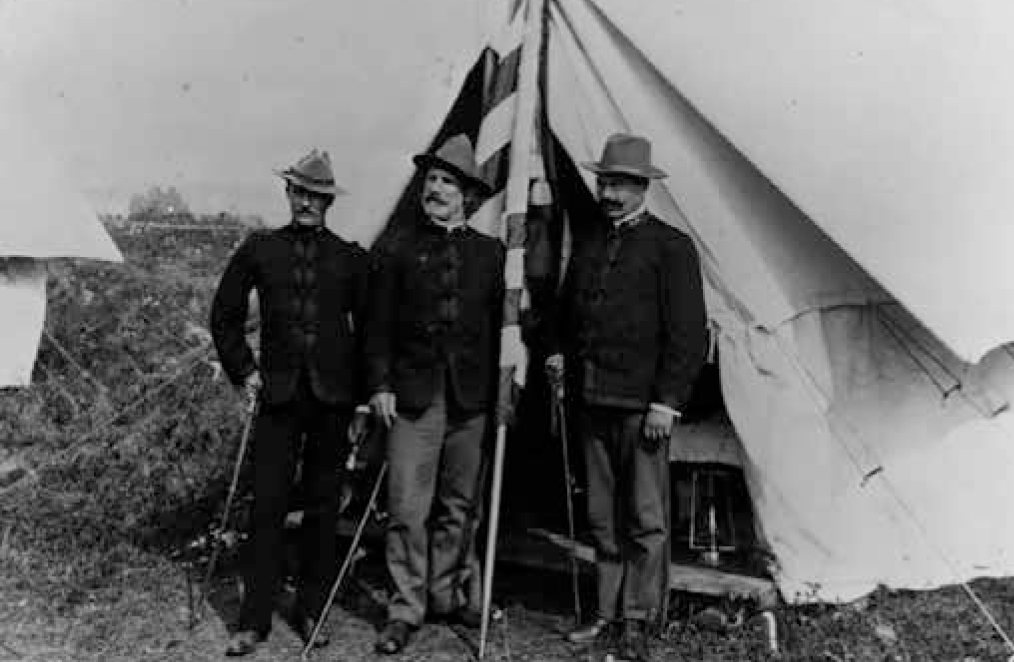
Marine officers who landed with 1st Marine Battalion (Reinforced) at Guantánamo, Cuba, on 10 June 1898 (from left): 1stLt Herbert L. Draper, adjutant; Col Robert W. Huntington, battalion commander; and Capt Charles L. McCawley, assistant quartermaster. Defense Department (Marine Corps) 514827
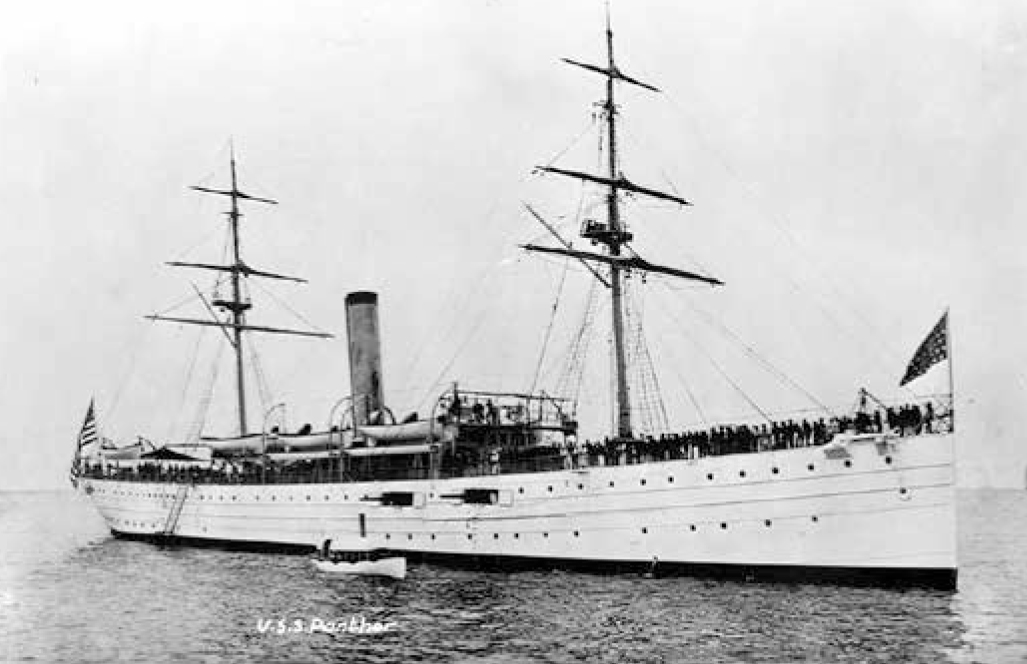
USS Panther, ca. 1902–3. Naval History and Heritage Command, NH68336
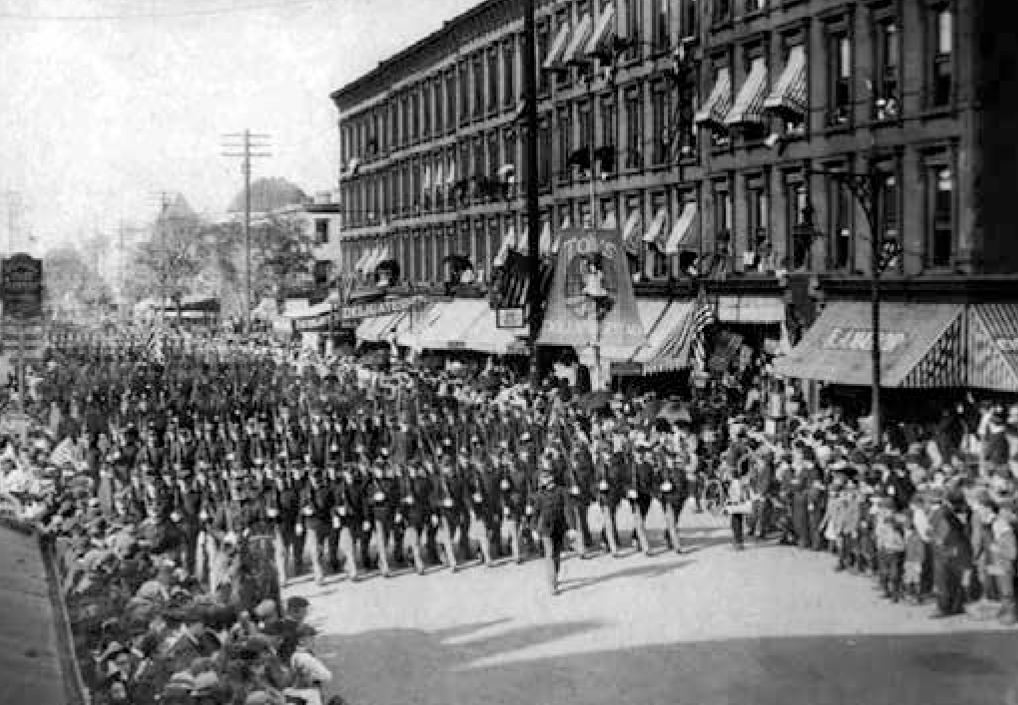
Marching off to war in the late afternoon on Friday, 22 April 1898, the battalion, preceded by the New York Navy Yard band playing the popular “The Girl I Left behind Me,” is led down Navy Street in Brooklyn, NY, under the command of LtCol Huntington astride Old Tom (Capt George F. Elliot’s charger). Marine Corps Archives Branch, History Division
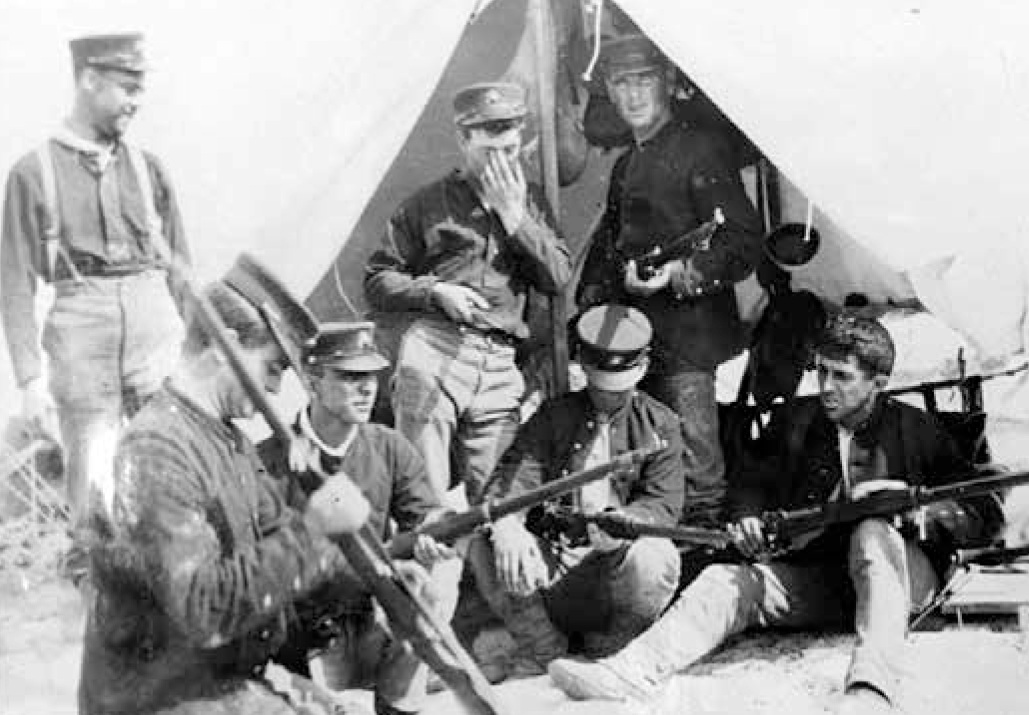
U.S. Marines of Huntington’s Battalion training at Key West, FL, prior to the invasion of Cuba, 1898. Marine Corps Historical Reference Branch, History Division, courtesy of Col Robert W. Huntington
Moreover, Ritter, following Navy custom, insisted on establishing his authority over the Marines on every matter, large or small. While this certainly was his prerogative in regard to a normal Marine Corps ship’s detachment, Huntington believed that this authority was overstated in regard to an embarked Marine battalion, which was under the command of its duly appointed commander. Timely intervention at one point by the overall flotilla commander, Commander McCalla of the warship USS Marblehead (CL 12), ensured the cooperation of both the ship’s captain and commander of the landing force for the duration of the operation.
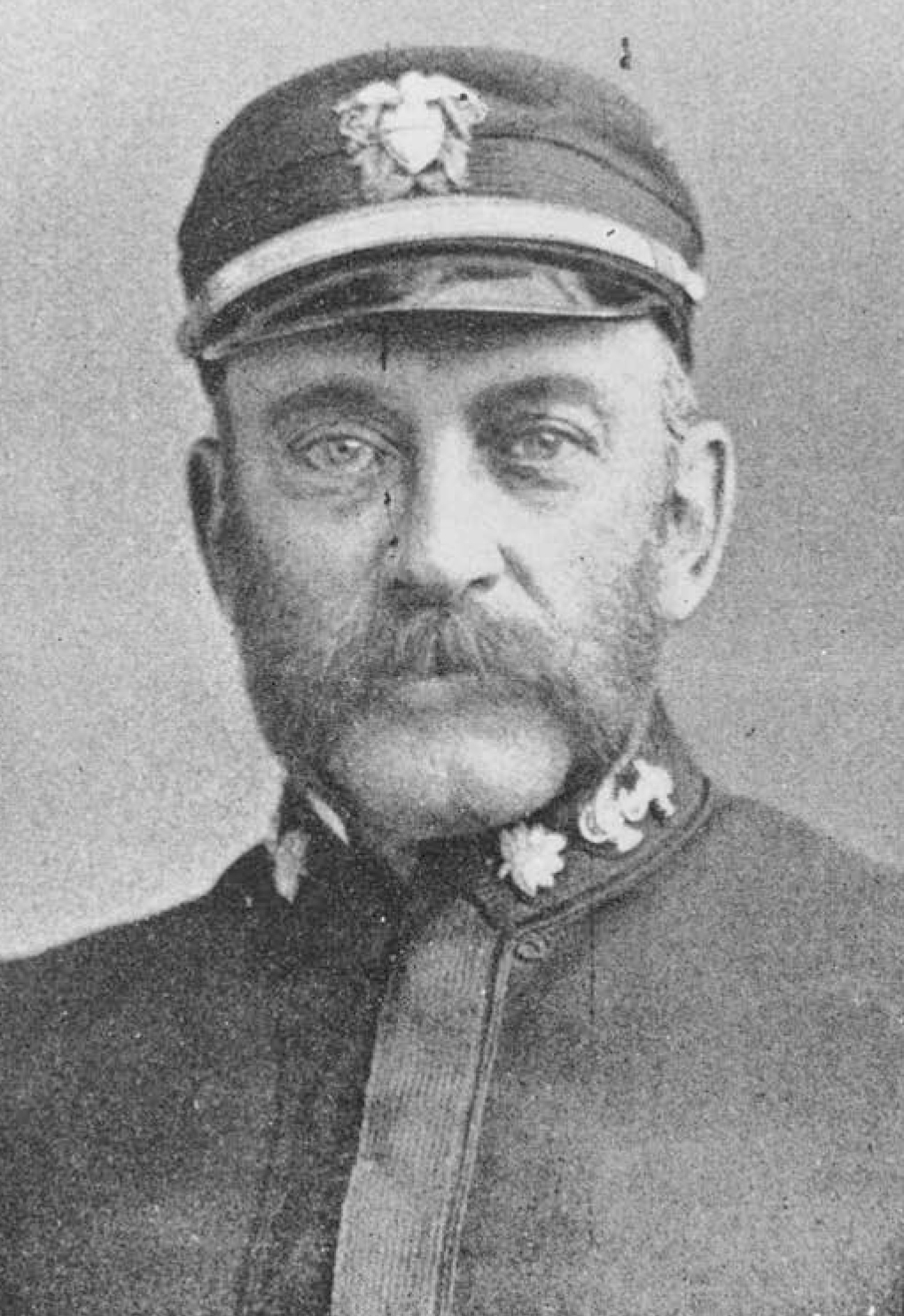
CDR Bowman H. McCalla, captain of the USS Marblehead at Guantánamo Bay, Cuba. Naval History and Heritage Command, NH72745
Nevertheless, Huntington’s Battalion was successfully landed on 10 June with all of his men, guns, tents, and equipage and they immediately went about securing the heights surrounding the bay. The Spanish defending force was resoundingly defeated at the Battle of Cuzco Wells on 14 June, leaving the battlefield to the Marines. Not only did the Marines fight ashore as an independent, all-arms force for the first time, new techniques in ship-to-shore communication, fire support, and inter-Service cooperation also were established, if not perfected. With the heights secure and the Spanish bottled up safely in the town of Caimanera, McCalla’s flotilla sailed into the excellent harbor and used it continuously for the next several months, which was finally established as a permanent U.S. naval base by treaty when the war was over. Following the war’s conclusion, Huntington and his Marines sailed back to the United States, arriving at Portsmouth, New Hampshire, on 26 August 1898.6 Back on American soil on 19 September 1898, Colonel Commandant Heywood ordered the battalion paraded and then had it disbanded, with its Marines being sent back to the various East Coast barracks and naval installations from whence they had come.7 Although Huntington’s Battalion had successfully accomplished its mission, Heywood did not contemplate this expeditionary adventure becoming a standing requirement. Instead, the Colonel Commandant saw it as a distraction from the Marine Corps’ traditional role, which he felt was continuing to serve as ship’s detachments and guarding the various naval installations throughout the United States. Whether he or the Marine Corps cared for the concept or not, the afloat-ready battalion had proven itself in practice, and the U.S. Navy took notice.
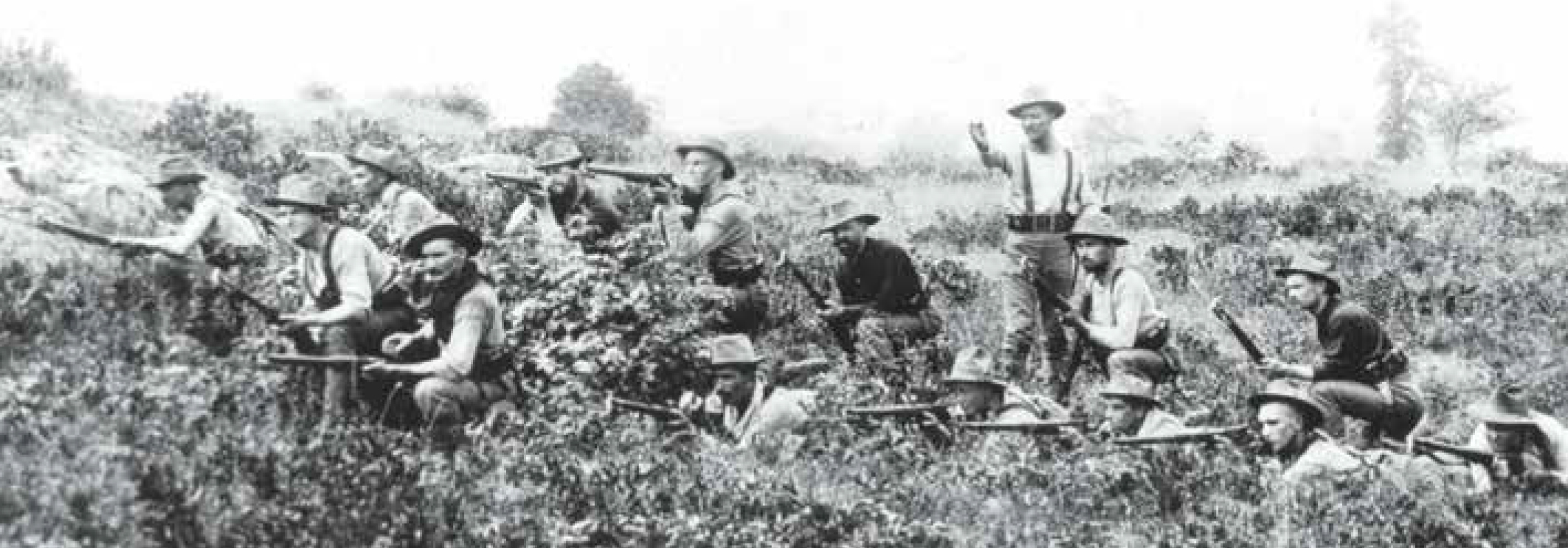
The first bloody engagement of U.S. troops on Cuban soil. U.S. Marines going ashore at Guantánamo with their Krag–Jørgensen rifles in June 1898. Official U.S. Marine Corps photo
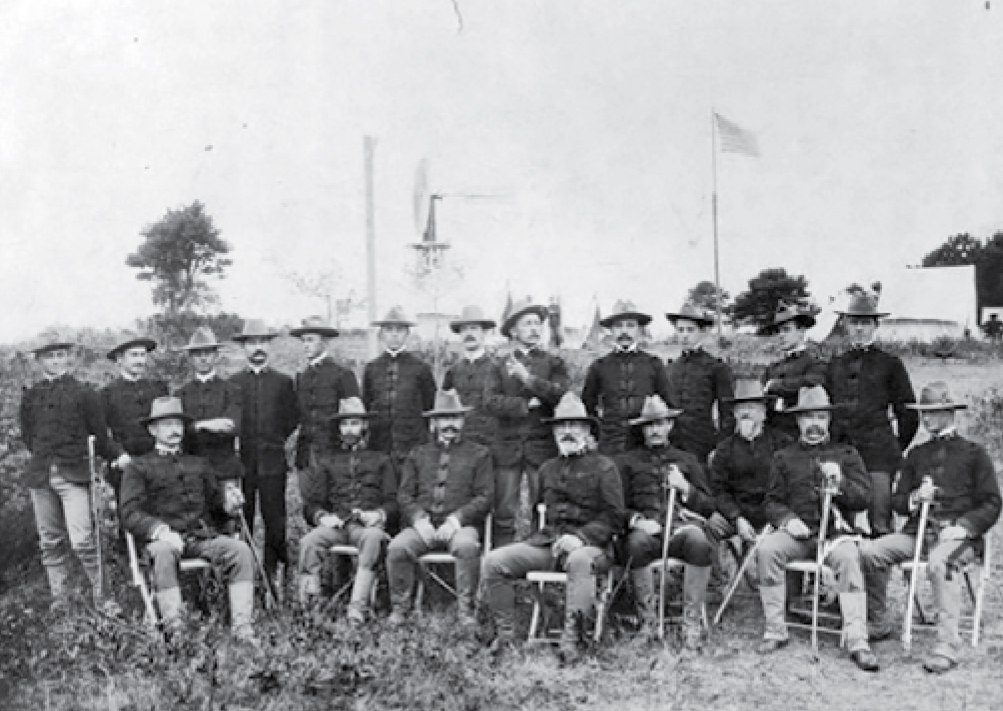
Group of Marine officers at Portsmouth, NH, immediately after the Spanish-American War and their return from Cuba. Col Huntington (front row, fifth from right) with his line and staff officers, August 1898. Defense Department (Marine Corps) 515613
The Afloat-Ready Battalion Concept Revived by the Navy
The next incarnation of the afloat-ready battalion came four years later in the form of Russell’s, Haines’, Pope’s, and Lejeune’s Battalions. At the beginning of September 1902, the USS Panther once again embarked a Marine battalion (16 officers and 325 enlisted men) at the request of Secretary of the Navy William H. Moody, who had stated his desire the previous July to have such a battalion ready for training with the fleet, as well as to be on hand to serve in an expeditionary capacity and ready to land anywhere the fleet deemed it desirable to do so.8
Commanded by Lieutenant Colonel Benjamin R. Russell, this first afloat-ready battalion was composed of men from the Marine Barracks Brooklyn Navy Yard and Philadelphia Navy Yard. Hastily formed for service in what they were told would be Western Caribbean waters, the battalion sailed on 14 September 1902. Upon arrival off the coast of Columbia, the Panther would serve as a station ship, able to launch an expeditionary battalion-size landing force anywhere in the region at a moment’s notice. It and its three successor battalions would protect American interests during ongoing unrest in Honduras and Panama for the next 16 months, serving as an important tool of U.S. national policy in the region. The Marines did not have to wait long. On 23 September, on orders from Rear Admiral Silas Casey III, commander of naval forces in the Caribbean, Russell and his Marines landed at Colón in what is now modern-day Panama, to protect U.S. interests during a period of civil unrest between Colombia and the United States, which exercised governmental authority over the region where the Panama Canal was being built. The landing of a disciplined battalion of well-armed and -equipped Marines, and its visible presence throughout the city, was enough to convince the warring parties—loyalists and separatists—to stand down and cease their violent acts against the local government in Colón and American businesses.
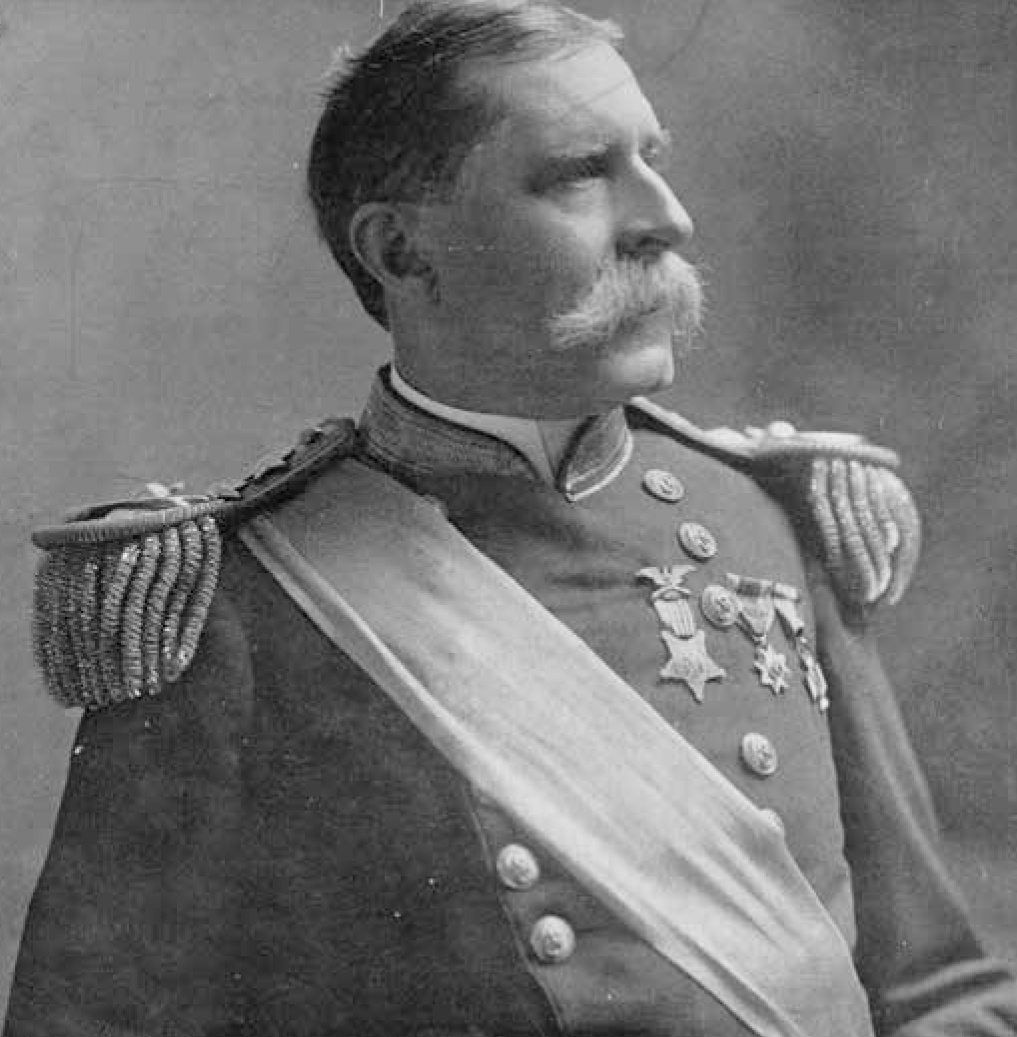
Maj General Charles C. Heywood, 9th Commandant of the Marine Corps (1891–1903). During his tenure, he expanded the Corps and helped strengthen its amphibious capabilities. Naval History and Heritage Command, NH49185
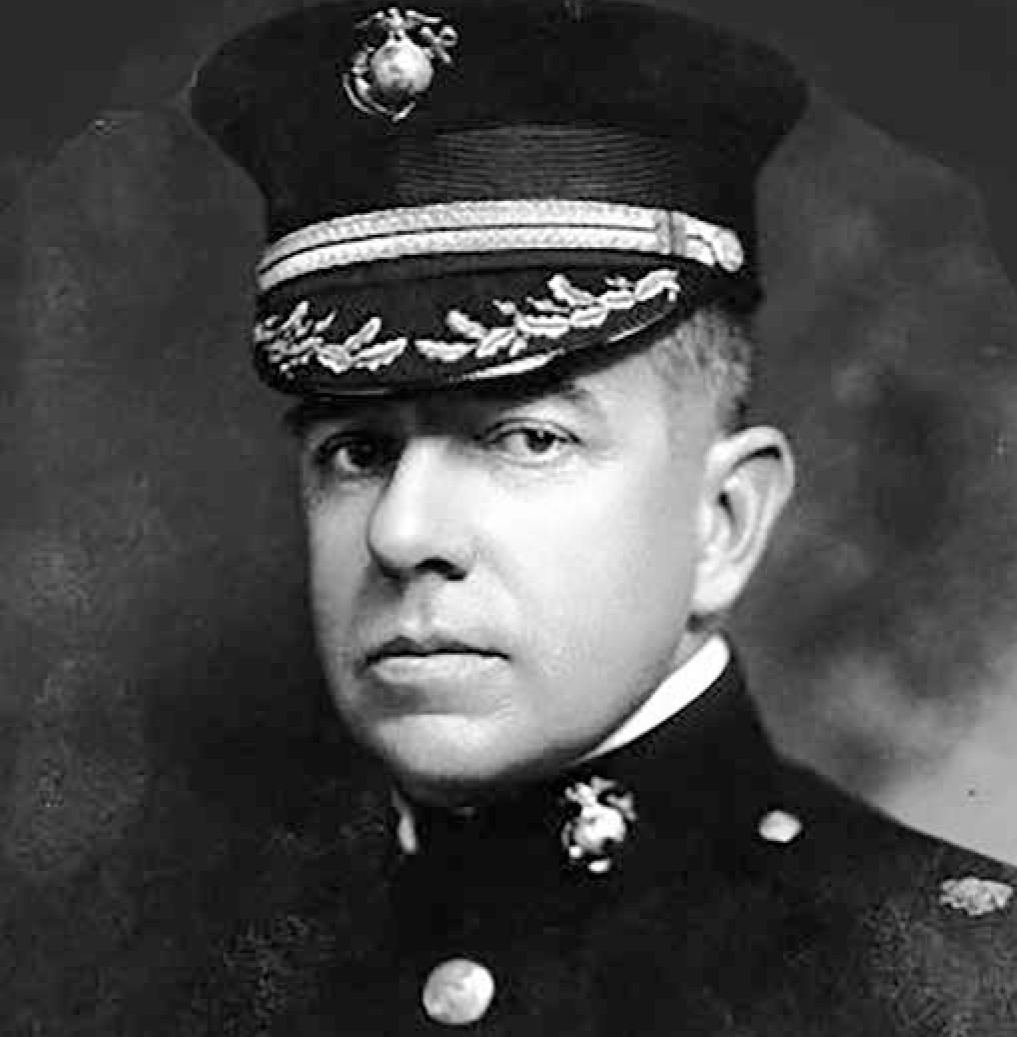
Col John H. Russell Jr., commander of Russell’s Battalion, shown here as a major in 1902, U.S. Naval Academy Class of 1892 and future Major General Commandant of the Marine Corps. Marine Corps Historical Reference Branch, History Division photo
After two uneventful months of patrolling and supporting the local police, the battalion once again embarked on board the Panther on 18 November and sailed for the advanced naval base at Culebra, an island off the coast of Puerto Rico, where the Marines disembarked and conducted training ashore.9 By 30 November 1902, most of Russell’s men had become sick from various tropical diseases incurred after two and a half months of service in the Caribbean, forcing the weakened battalion to return to the United States, where it was immediately disbanded. Despite the lingering effects of the various tropical illnesses, the presence of an armed and well-trained battalion of Marines embarked aboard a station ship had proved its worth.
Meanwhile, once again at the behest of the Navy, another Marine battalion was formed on 5 November that same year in Norfolk, also for service in the Caribbean. This battalion, commanded by Colonel Percival C. Pope, was sent directly to Culebra aboard the transport USS Prairie (AD 5) to train with Russell’s Battalion, since the immediate need for troops in Panama had seemingly passed. Discovering that Russell’s Battalion had been forced to return to the United States for health reasons, the flotilla commander decided to keep Pope’s Battalion on station aboard the Prairie instead.
Pope was no stranger to service afloat. He had served on the staff of Huntington’s Battalion at Guantánamo Bay and was a good choice to lead the new battalion, which was nearly twice as large as Russell’s. It was a balanced force, consisting of 600 men organized into six companies, along with artillery, machine guns, and rudimentary signal equipment. However, in fleshing out this battalion, the East Coast was effectively denuded of nearly every able-bodied Marine who had not deployed with Russell five months earlier. It also forced the Colonel Commandant to delay his plans to create an advanced base defense force, which had become the Marine Corps’ primary focus since the Spanish-American War.
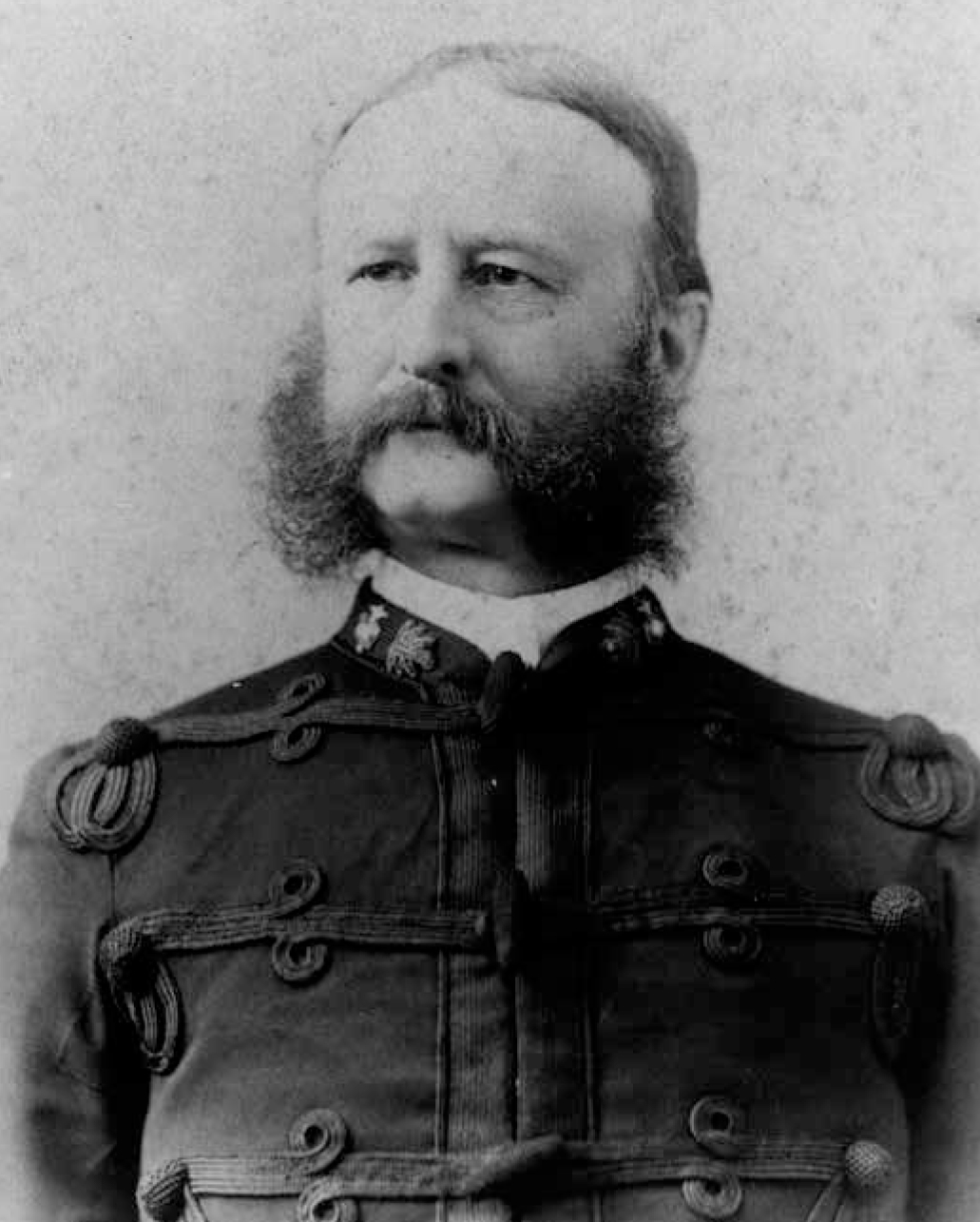
Col Percival C. Pope (shown here as a major in 1890), commander of Pope’s Battalion, 1902. Naval History and Heritage Command, NH85788
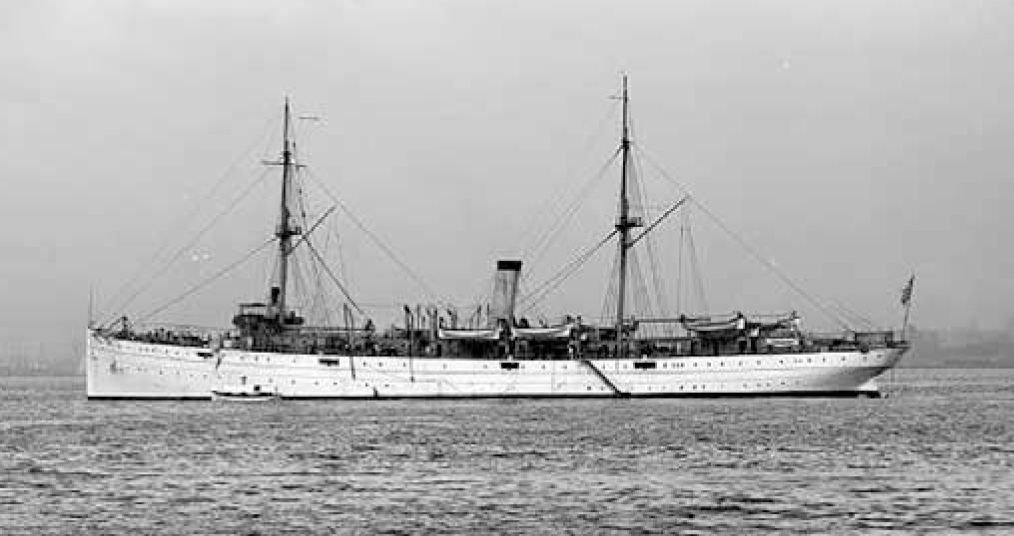
USS Prairie in a harbor, while she was fitted with sailing rig for training ship service, ca. 1901–5. Naval History and Heritage Command, NH105835
Emphasis Shifts to Advanced Base Force
With its traditional role of serving as ship’s detachments threatened by the increasing modernization of the Navy, which felt that it no longer needed such a seemingly anachronistic body of troops on board its ships, Marine Corps leaders belatedly realized that the advanced base force was where its future lay.10 After its victory in 1898, the United States had acquired a farflung overseas empire with coaling stations located all around the globe that needed to be defended or seized if the president deemed it necessary. The ensuing deployments of not only Pope’s Battalion in an expeditionary capacity, but of two subsequent ones, forced Heywood to delay his plans for creating such a force for at least two more years, since it was patently obvious that nothing could be done until the Navy overcame its desire to keep large numbers of Marines embarked on station ships or until it became impractical to continue doing so.
Nevertheless, Admiral George Dewey, commander of the Atlantic Fleet and hero of the Battle of Manila Bay, remained enthusiastic about the utility of an embarked ready battalion. Shortly after the Spanish-American War had concluded, he commented that “If there had been 5,000 Marines under my command at Manila Bay, the city would have surrendered to me on May 1, 1898, and could have been properly garrisoned.”11 The further utility of the Marines for service in the Caribbean was evinced by Dewey’s deputy, Rear Admiral H. C. Taylor, in a letter to the secretary of the Navy, in which he asserted that the Marines served two purposes: one of “being ready for service anywhere,” and the other “that of improving the base and harbor” of Culebra as “a most valuable adjunct.”12 It was not an entirely negative development for Pope’s Marines, who gained valuable experience in constructing and defending an advanced base during a lengthy exercise carried out by the Navy that ended on 3 January 1903. That same month, Colonel Pope handed over command of his battalion in Culebra to Major Henry C. Haines, who then was ordered to transfer his Marines back aboard the creaking Panther later that month. They would serve aboard this station ship as part of the Atlantic Fleet’s newly activated “Caribbean Squadron” until late July 1903. Finally landed in Maine to take part in Army-Navy joint maneuvers at the end of that month, Haines and his battalion sailed to the Philadelphia Navy Yard in August 1903, where he was relieved of command by Major John A. Lejeune in October.
The Floating Battalion of the Atlantic Fleet
Lejeune’s Battalion, now known by the Navy as the “Floating Battalion of the Atlantic Fleet,” then embarked aboard the transport USS Dixie (1893) and sailed once more to the Caribbean to take part in the upcoming 1903–4 winter maneuvers.13 That exercise never came to pass because Lejeune and his men were diverted from Culebra to Panama instead, where they went ashore at Colón on 5 November to discourage Colombian forces from invading. Joined two months later by Brigadier General George F. Elliott’s provisional Marine brigade, Lejeune and his men participated in the Panama Canal crisis of 1903–4, but did not see combat.
After Colombia backed down from its threats to invade Panama, mainly due to the presence of Elliott’s Brigade, peace was restored and Panamanian independence was formally recognized. No longer needed, Lejeune’s Battalion returned to the United States in February 1904, where it was finally disbanded.14
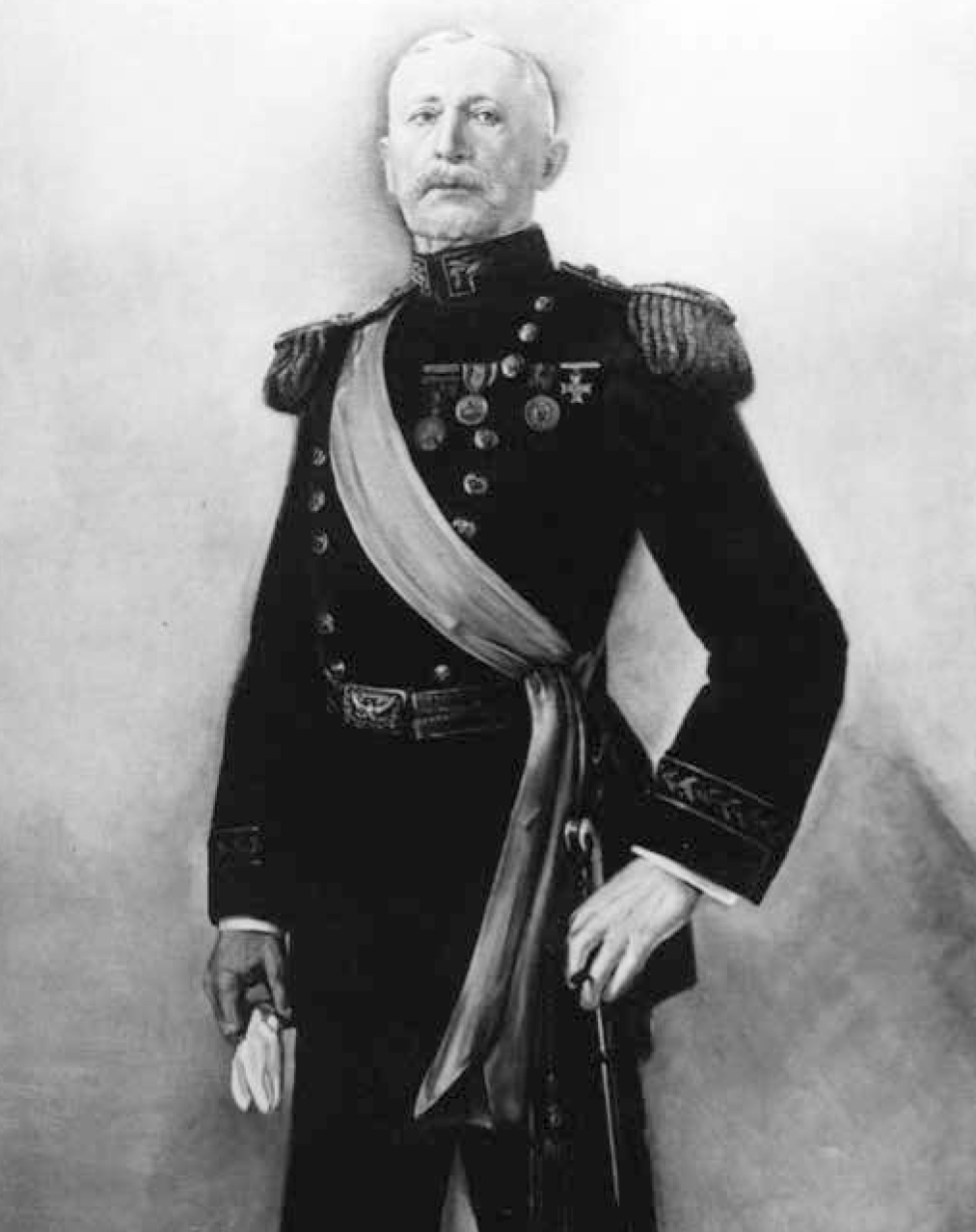
BGen George F. Elliot (shown here as a major general while serving as the 10th Commandant of the Marine Corps), commander of Elliott’s Brigade, 1903. Marine Corps History Division photo
Though Pope’s, Russel’s, Haines’, and Lejeune’s Battalions had satisfactorily served as precursors for the Navy’s forces afloat-ready concept, the Marine Corps recorded its objections to the overall concept, feeling that it was a diversion from what it saw as its evolving primary mission of serving as the fleet’s nascent base defense force. In addition to this objection, Colonel Commandant Heywood complained in 1903 that this unfunded program came out of the Marine Corps’ thinly stretched budget and was not compensated for by the Navy, that it used “borrowed” manpower needed elsewhere, and that the proper onboard equipment and small boats needed to receive, store, and land supplies were lacking on the ships used to carry the Marines. There was also the issue of the ships themselves—the USS Panther, Prairie, and Dixie—which were never intended to serve as troopships and had undergone inadequate conversion to prepare them for that role. They were cramped, poorly ventilated, and lacked adequate space for the embarked Marines to exercise or perform any sort of drills.
Another issue that continually raised its head was the never-ending conflict of authority between the successive Marine battalion commanders and each ship’s captain. In many cases, not only did the ship’s captain insist on enforcing his writ upon every Marine on board, circumventing the Marine Corps chain of command, but some ship’s captains also attempted to give precise instructions on the employment of the Marines once they had gone ashore. However it might vex Colonel Commandant Heywood and his successor Brigadier General Commandant Elliott, there was little either of them could do about it, since they had no authority over their Marines from Washington, DC, once they were sailing as part of the fleet, unless, like Elliott, he sailed with his Marines to command them in person as commander of the provisional brigade sent to Panama.
While Heywood or Elliott could complain to the Navy about this practice, both had to confront the admiral’s belief, deeply rooted in tradition, that anyone embarked on a U.S. Navy warship was subject to the captain’s authority. Heywood, when he first confronted this assertion, countered that this was nonsense, given that the Panther, Prairie, and Dixie were mere troopships, which by naval custom gave the commander of the landing force authority over his own men. Unfortunately for Heywood, the Navy’s counterargument that the presence of a few small-caliber cannon on board these converted freighters buttressed its contention that these were indeed warships, which practically ended all discussion of the matter during the rest of his and Elliott’s tenure.
Despite the ineffective resistance of the Marine Corps, which was in any case subordinate to the Navy, the latter Service still wanted to continue the practice. After the success in Panama and elsewhere, the Navy believed that an embarked battalion of Marines enhanced the Navy’s expeditionary capability. However, events conspired to end the practice altogether for nearly 43 years. During the first decade of the twentieth century, the United States quickly discovered that its new overseas empire needed to be policed and that the numbers of troops on hand, both Army and Marine Corps, were insufficient for the purpose. The Marine Corps especially found itself pulled in every direction, having to send detachments to protect new naval bases in the Philippines, Guam, Puerto Rico, and Cuba, as well as the American legation in China. While the authorized size of the Marine Corps had increased, it still had not attained the minimum number of Marines that Colonel Commandant Heywood felt adequate—a total of 10,000 men—to meet all of the Corps’ commitments, most especially when it was focused on the evolving advanced base defense force concept.
The dichotomy between the desires of the Navy, which wanted an expeditionary afloat-ready battalion, and the Marines Corps, which wanted an advanced base defense force, would continue unresolved until 1947. During the interval, both Services were consumed by a variety of challenges, including modernizing the fleet, fighting World War I, participating in a series of protracted counterguerrilla and nation-building operations in the Caribbean during the 1920s and ’30s (the Banana Wars), experimenting with air-ground cooperation, and—most important from the Marine Corps perspective—developing and maturing the advanced base force concept that included the concept of amphibious assault against a defended beachhead. These and other events, including successfully waging World War II, required the complete dedication and cooperation of both sea Services to achieve their goals.
Afloat-Ready Battalion Concept Rediscovered by State Department
This is where things stood until December 1947, when the concept was resurrected at the beginning of the Cold War. On this occasion, it was not the Navy that called for an afloat-ready force, but the U.S. Department of State, which felt that the United States needed a variety of policy options to employ as a counter to what had become an increasingly belligerent and assertive Soviet Union. In April and again in December of that year, Ambassador George F. Kennan called for a scalable, highly mobile amphibious reaction force that could be based at sea and prepared to conduct a landing operation anywhere in the Mediterranean Sea to assist U.S. allies threatened by Communist expansion.15 Instead of seeking a military confrontation with the Soviet Union, which was engaged in destabilizing several Western European nations and consolidating its control over Eastern Europe, Kennan believed that U.S. goals would best be achieved by containing the Soviet threat over a long period by using diplomatic, informational, military, and economic (DIME) levers of power.
Kennan was serving at the time as Secretary of State George C. Marshall Jr.’s influential director of policy planning and was highly respected throughout the U.S. government for his depth of understanding of the growing Soviet menace. When the Soviet Union began to exert diplomatic and military pressure upon Greece and Italy throughout the summer and fall of 1947, the State Department was able to convince President Harry S. Truman that to assist these democratic governments, both threatened by Communist agitation, the Navy could help further the nascent “containment policy” and Truman Doctrine against the Soviet Union by conducting a variety of fleet exercises and amphibious demonstrations that would send a signal to Josef Stalin of the inadvisability of continuing his destabilizing actions.16
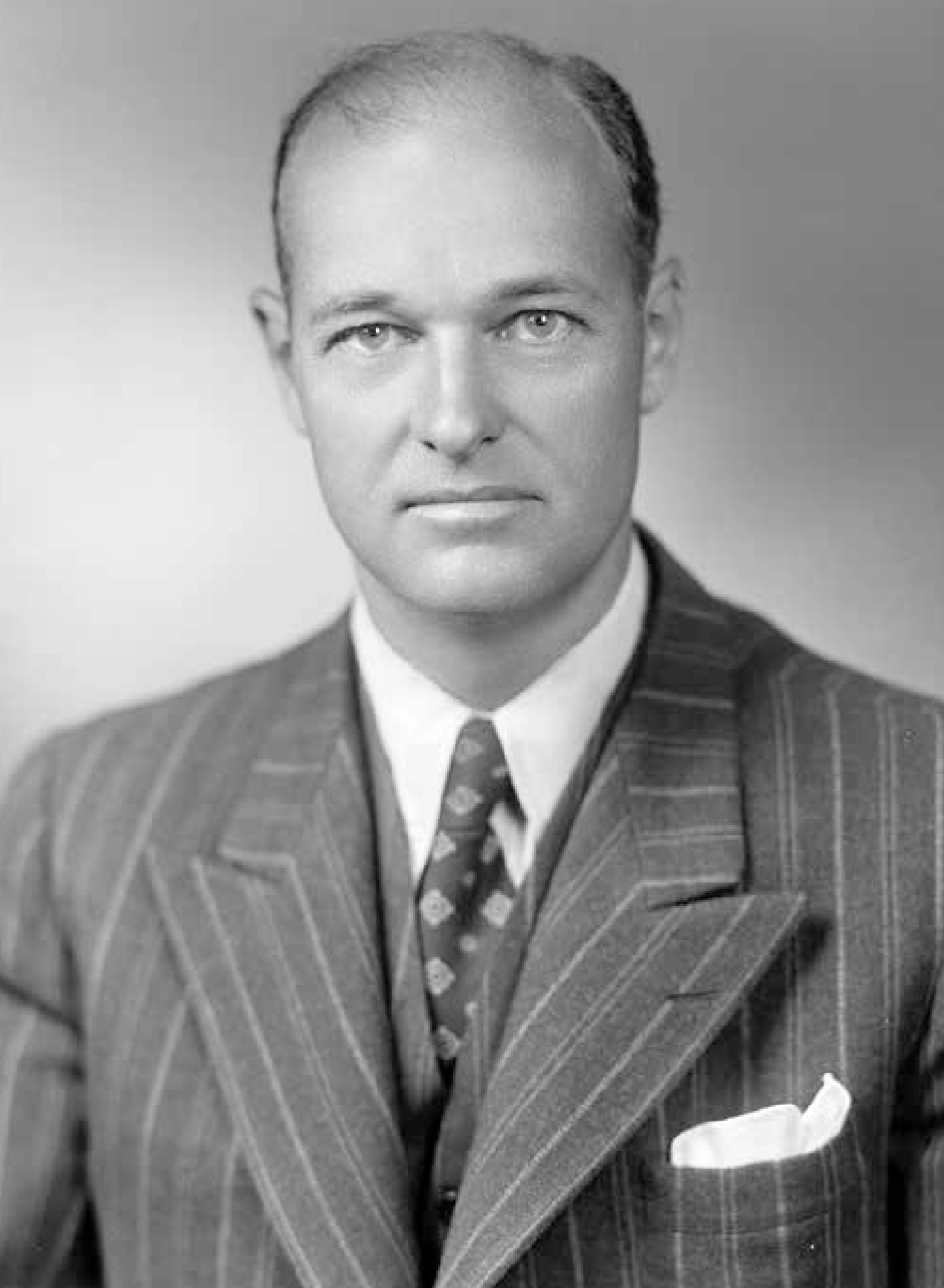
Ambassador George F. Kennan in 1947. Library of Congress, Prints and Photographs Division, HEC12925
Consequently, in addition to sending additional ships of the Sixth Fleet to the eastern Mediterranean as ordered by the president, the commander of U.S. naval forces in the Mediterranean, Vice Admiral Bernhard H. Bieri, also requested that a battalion-size Marine Corps landing force be deployed to bolster the fleet’s striking power, which up to that point did not include any battalion landing teams. The request was duly approved and an order by the chief of naval operations dated 20 December 1947 directed the temporary assignment of a reinforced Marine battalion to augment existing Marine detachments on Sixth Fleet warships and to provide a ready landing force.17 This order brought about the actual resurrection and implementation of the afloat-ready battalion concept, the first time since Pope’s, Haines’, Russel’s, and Lejeune’s Battalions of 1902–4 that an amphibious expeditionary force would embark aboard Navy ships and remain on station, awaiting a possible contingency order that could result in their landing on a foreign shore at a moment’s notice.
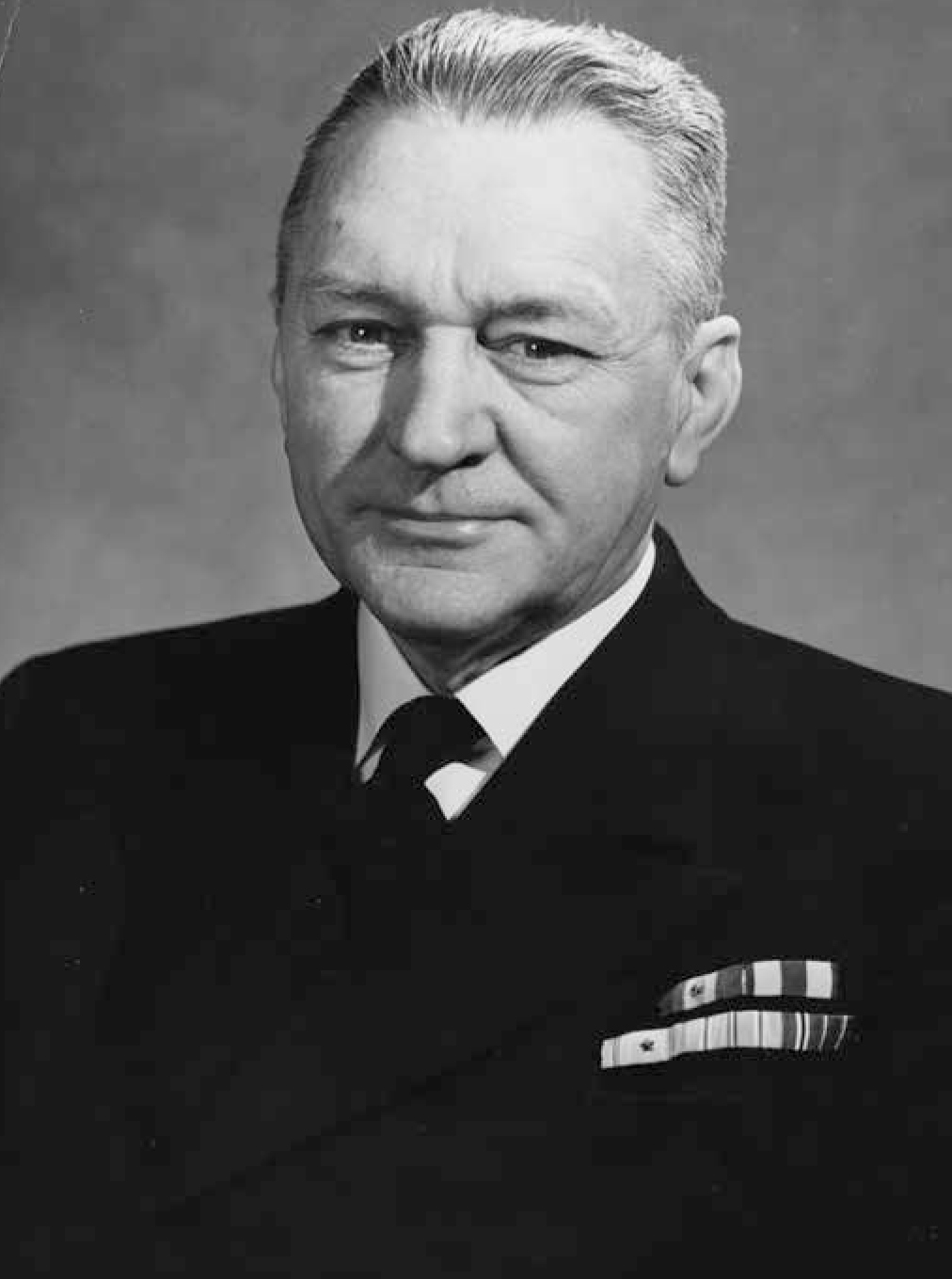
RAdm Bernhard H. Bieri, U.S. Navy. Naval History and Heritage Command, NH80-G-701987
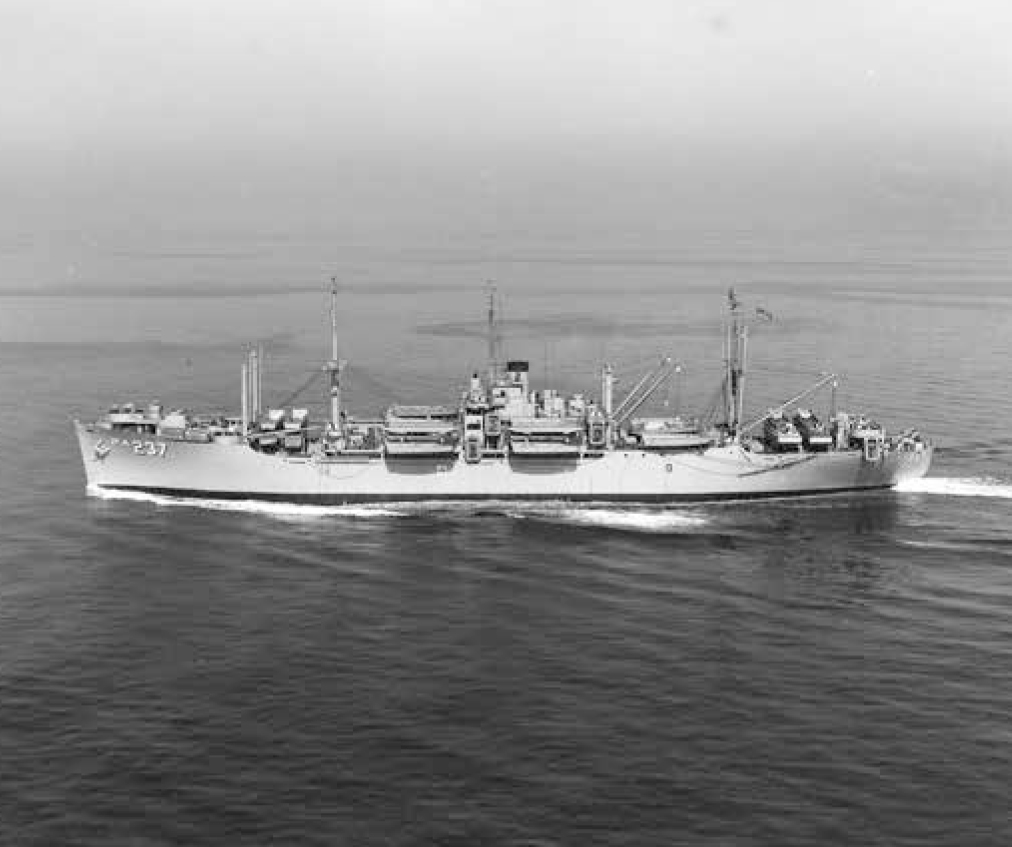
USS Bexar (APA 237) underway off San Diego, CA, ca. 1954. Naval History and Heritage Command, NH66834
Within days of receiving this order, a battalion landing team of 1,000 Marines from the 2d Marine Regiment (Reinforced), along with vehicles, tanks, artillery, and supplies, formed up and began loading on board the World War II-vintage U.S. Navy attack transports USS Bexar (APA 237) and USS Montague (AKA 98) in Morehead City, North Carolina.18 Sailing from the East Coast on 5 January 1948, this force remained afloat with the Sixth Fleet for three months in the eastern Mediterranean, returning on 12 March 1948 after being replaced by a similar battalion from Camp Lejeune, North Carolina, a move that initiated a series of cruises that would normally last six months. Unlike its lukewarm acceptance of the concept in 1903, the Marine Corps embraced this new mission enthusiastically. Embroiled as it was in the 1947–48 military roles and missions debate, which involved nothing less than the continuing survival of the Marine Corps as a Service, this type of mission was tailor-made for what it specialized in—expeditionary operations and amphibious assault—as part of the Navy’s “balanced fleet.”19 Having proven its ability to carry out these kinds of assignments in the Pacific during World War II, the Marine Corps felt that it was uniquely suited for the afloat-ready battalion mission in the Mediterranean, as compared to the U.S. Army, which was almost fully committed to occupation duties in Germany, Japan, China, and Italy. The greatest obstacle to filling the Navy’s requirement was that the number of existing battalion landing teams had been reduced to six, of which only half were considered to be available for service with the Sixth Fleet in the Mediterranean, the Caribbean, and elsewhere.20 Though it was never committed to battle, the first afloat-ready battalion to deploy to the Mediterranean participated in several amphibious exercises within close proximity of Greece and Italy, a move that the Soviets could not fail to notice. Combined with other political and military signals being sent by the U.S. government at the time, the presence of the amphibious force and the national resolve that it signified were enough to influence the Soviet Union to decrease its support to the Communist rebel movements in Greece, Italy, and Turkey, granting the governments of these countries the breathing space they needed to renew efforts to bolster their defenses against their respective insurgencies.21
Evolution of the Mediterranean Afloat Battalion 1948–60
This first afloat-ready battalion, though still a powerful unit by today’s standards, was not a true combined Marine air-ground organization in the modern sense. The battalion landing team was not paired with an aviation component and lacked a commander and staff to exercise command and control of any Marine Corps air and ground units that might operate together. It was completely dependent on its troop transports for logistical support, having none of its own, rendering it unable to operate independently ashore for more than a few days. To compound command and control issues, neither the Bexar nor the Montague was equipped with the communications gear that would have allowed the battalion commander to exercise control over his forces while afloat. It was a stopgap, expedient solution but it was enough to send the right message of political will.
Though Marine fixed-wing aircraft were operating aboard aircraft carriers of the Sixth Fleet at the time, they fell under the Navy’s control and were not considered to be part of the afloat-ready battalion’s “force package” or authorized temporary organizational structure. The battalion and its equipment were not configured for an amphibious assault either, since neither of the two attack transports were accompanied by the necessary landing ships, tank (LSTs) nor did they carry any landing vehicles, tracked (LVTs) like those recently used during the war with Japan with such great effect. It also had no helicopters of its own, a newly introduced aerial system that had not yet gone far beyond the experimental stage but one that showed great future promise as a means of landing troops in support of an amphibious assault.
Nevertheless, this move initiated the Marine Corps’ practice of maintaining an air and landing force with the Sixth Fleet in the Mediterranean on a recurring basis, a practice which, except for short-term breaks in continuity due to overwhelming requirements for troops elsewhere (e.g., the Korean and Vietnam Wars), has continued from 1948 to the present day. That same year, this afloat-ready battalion also was given its first name—the Naval Forces, Eastern Atlantic and Mediterranean Battalion, or NELM Battalion.22 In 1960, the Sixth Fleet redesignated it as the Landing Force, Mediterranean, or LanForMed, but little else changed.
The Doctrinal Revolution of the 1950s
Except for the existing battalion landing team doctrine dating back to the late 1940s, the Marine Corps had yet to devise a tactical system or a way of thinking about how to incorporate all of the disparate elements needed to make such an air-ground force capable of operating in a nuclear environment complete. Even had there been doctrine, or helicopters advanced enough to carry troops and cargo, in 1948 there was as yet no ship suitable enough to serve as a floating base, though aircraft carriers did hold promise. Unfortunately, the Navy was reluctant to allocate its large fleet carriers or the funding for such a project, not convinced yet that the helicopter would prove itself as the panacea that the Marine Corps thought it was. Fixed-wing aviation continued to operate from aircraft carriers assigned to the various fleets.
Between January 1948 and early 1960, a succession of NELM Battalions continued sailing with the Sixth Fleet throughout the Mediterranean. However, a portent of the future gradually began to take shape upon the publication of a bulletin on 9 November 1954 written by General Lemuel C. Shepherd Jr., Commandant of the Marine Corps.23 Weighing the increasing capability of the Marine Corps’ rotary-and fixed-wing aviation elements, and foreseeing how they might work in concert with ground combat elements, Shepherd decreed that a new organizational structure—what he termed a Marine Air-Ground Task Force, or MAGTF—would be needed in the future to enable the Marine Corps to continue its amphibious warfare mission while at the same time leveraging new technology to make it a more lethal and agile force.
Shepherd stated that the “future employment of Fleet Marine Force elements will normally involve organization as air-ground task forces in which air and ground units will habitually operate as a single operational command” and that this Marine Air-Ground Task Force should consist of a balanced all-arms team.24 Shepherd was not prescriptive in the bulletin as to the actual makeup of the force, but he was clearly influenced by the all-helicopter amphibious assault concept, commonly referred to as vertical envelopment, which foresaw an even greater employment of the helicopter than was possible at the time. More importantly, Shepherd stressed the importance of all arms—air, ground, and logistics—being placed under the command of a single Marine commander not tasked with the additional duty of commanding one of the MAGTF’s components.25
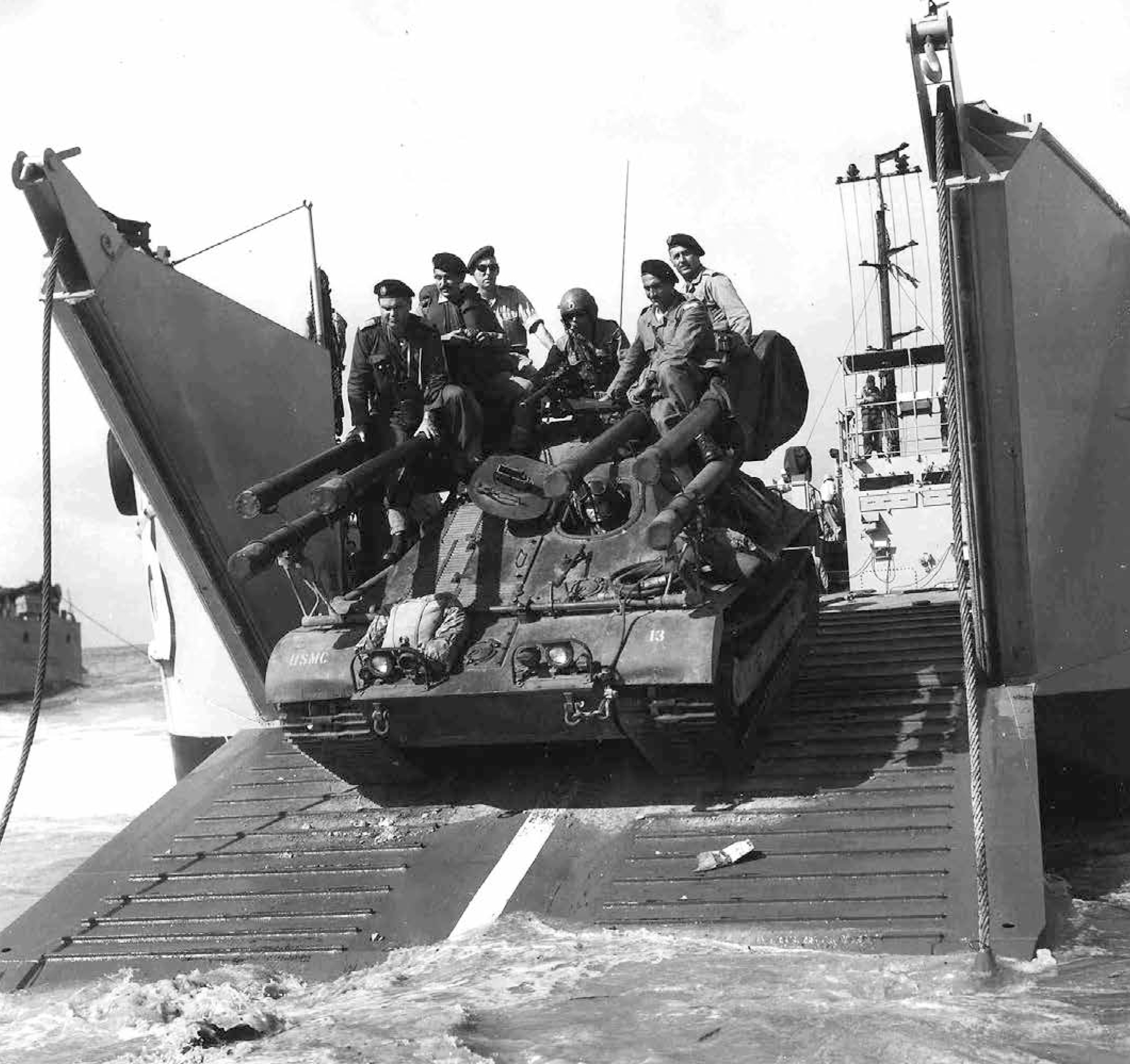
U.S. Marines and Lebanese Army personnel debark from LCTs with one of the Marine Corps’ new M50 Ontos, light armored antitank vehicle. This unit was from the NELM Battalion assigned to the Navy’s Sixth Fleet. Defense Department (Marine Corps) A17399
While Shepherd’s bulletin was important, it was not yet settled as doctrine and commanders of Marine Corps units in service with the various fleets were not bound to follow it. A year later, however, Shepherd’s thoughts were reinforced by Concept of Future Amphibious Operations, Landing Force Bulletin 17 (LFB- 17), which did have the force of doctrine behind it.26 This bulletin stressed that the MAGTF concept was uniquely suited toward the conduct of vertical envelopment as part of amphibious operations in a nuclear environment and that MAGTFs must leverage all of its elements to achieve success. However, the bulletin did not actually provide much guidance concerning how the doctrine was to be put into practice, leaving it up to the commanders to decide what a MAGTF actually was and what it would look like. Additionally, the Marine Corps was still without a suitable seagoing platform to carry such a force, even had there been a consensus with the Navy as to what it was to be. Though smaller escort carriers had been made temporarily available to the Marine Corps for training exercises and experimental purposes since 1948, no dedicated or purpose-built Navy ships yet existed that could transport and support the kind of MAGTF that Shepherd envisioned.
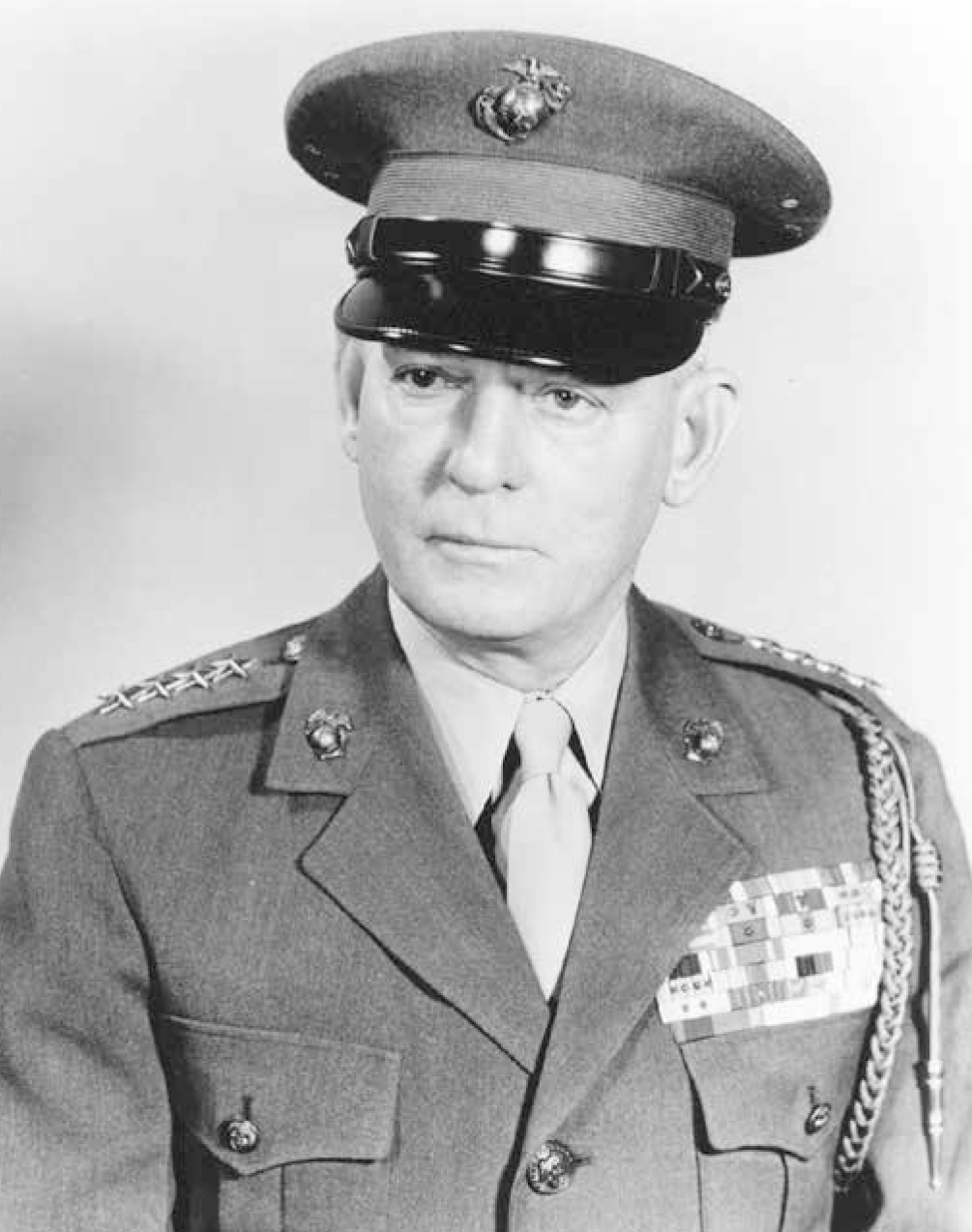
Gen Lemuel C. Shepherd, 20th Commandant of the Marine Corps (1952–56). Marine Corps Historical Reference Branch, History Division photo
Impact of New Doctrine on the Fleet Marine Force
Armed with the knowledge that incorporating helicopters into the afloat-ready battalion concept was now expected to become standard practice, beginning in 1956, all three Marine Expeditionary Forces, or MEFs (I MEF, II MEF, and III MEF), began to experiment using the forces assigned to them; but each MEF headquarters, faced with different challenges posed by its area of operations and the availability of amphibious shipping, approached the matter differently. One of the first prototype MAGTFs that deployed consisted of 6th Marine Regiment Headquarters, with one battalion landing team, joined by two Marine Medium Helicopter Squadrons (HMM)—HMM-261 and HMM-262. This force left Morehead City for NELM Battalion duty with the Sixth Fleet in the Mediterranean on 20 August 1957, making it the first standing MAGTF to serve in that capacity on a rotating basis.27 The regimental headquarters served as the overall command and control element of the MAGTF, but the limitations of existing amphibious shipping meant that its helicopters had to embark aboard fleet carriers, leaving the MAGTF commander with little authority over their employment until they could be landed and joined with the rest of the MAGTF ashore, the same procedure that governed employment of fixed-wing aircraft.
Throughout the late 1950s and early 1960s, there were many examples of the NELM Battalion/ LanForMed being used to conduct noncombatant evacuation operations and to support humanitarian assistance operations, such as the Suez Crisis of 1956, the Lebanon Crisis of 1958, and the Cyprus Crisis of 1965, among others. On 14 July 1958, President Dwight D. Eisenhower ordered the NELM Battalion, along with two additional battalion landing teams, to land in Lebanon to evacuate American citizens and to forestall a coup of the democratically elected government. Joined by elements from the 2d Marine Division that were already afloat in the Mediterranean with the Sixth Fleet for an exercise, the NELM Battalion was quickly landed and began conducting operations nearly a week before the U.S. Army’s airborne task force, entirely dependent on airlift, arrived from Germany.28 The ability of the afloat-ready battalion with its associated aviation element to land and begin conducting operations within 48 hours of notification was a powerful testament to the utility of the concept, once again proving the usefulness it first demonstrated in 1898.
New and Modified Ships Make Their Appearance
Meanwhile, a new class of Navy ships pointed toward the possibilities of the modern MAGTF. On 20 July 1956, the USS Thetis Bay (CVE 90), a converted World War II escort carrier, was recommissioned by the Navy as a landing platform, helicopter (LPH) ship, which was the Marine Corps’ first amphibious assault ship able to embark both the troops from the battalion landing team and 12 aircraft from a composite helicopter squadron, combining the functions of both an aircraft carrier and attack transport, changing the way afloat-ready battalions would operate forever.29 Though the Thetis Bay primarily served as a training platform, it saw many operational deployments as the Marine Corps worked out the technical details of the vertical envelopment concept. On 10 November 1958, the first permanent Marine aviation detachment afloat was activated for service and would ultimately serve on board the USS Boxer (LPH 4), a converted World War II Essex-class fleet carrier, then undergoing conversion at Norfolk, Virginia.30 The unit was activated to provide supply, maintenance, and flight deck control to Marine helicopter squadrons and troops assigned to the Boxer once the ship was placed back into service.
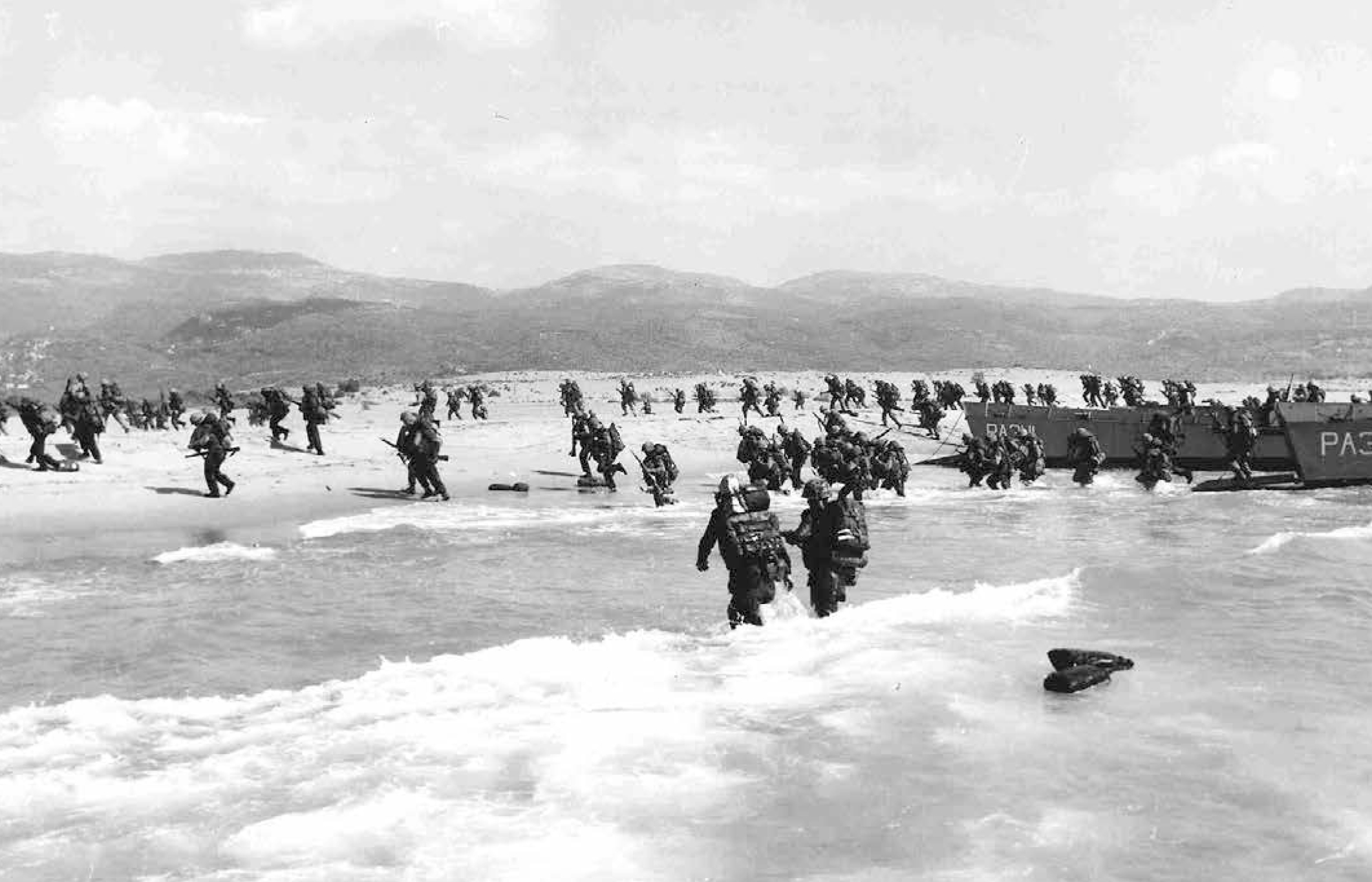
Marines landing in Lebanon, 15 July 1958. These were the first and second waves of Marines to hit the beach at the airport in Beirut. These Marines were from Golf Company, 2d Battalion, 2d Marines. Defense Department (Marine Corps) A17497, courtesy of TSgt Ed Scullin
This trend accelerated in 1959, when the USS Boxer was finally recommissioned on 30 January. Twice as large as the Thetis Bay, the Boxer carried up to 30 helicopters (21 on deck and 9 in the hangar deck) as well as nearly 2,000 Marines of an embarked battalion landing team.31 Two other converted Essex-class carriers, the USS Princeton (LPH 5) and USS Valley Forge (LPH 8), soon followed, joining the Boxer and the USS Thetis Bay.
Finally, the Marine Corps had the major pieces of what would constitute the future amphibious force, but these converted carriers had their limitations. For example, while they could embark troops via helicopters, they had no surface landing craft of their own, forcing the Navy and Marine Corps to continue to rely on LSTs and landing ship, docks (LSDs) to carry the ship-to-shore craft that would transport the bulk of the battalion landing team and the logistics elements ashore. These vessels were much slower than the Essex-class ships, often requiring the LPHs to sail separately. With four LPHs on hand between 1959 and 1964, the Marine Corps focused on merging the MAGTF concept with the afloat-ready battalion concept. The half-formed doctrine still lagged behind the evolution of landing craft and helicopters. Realizing this, the Navy and the Marine Corps began working closely together in both the Atlantic and Pacific Fleets as their experimentation progressed, though again each fleet approached the challenge differently. For example, in 1960, the Sixth Fleet in the Mediterranean Sea announced the initiation of the Fast Amphibious Force (FAF) concept.
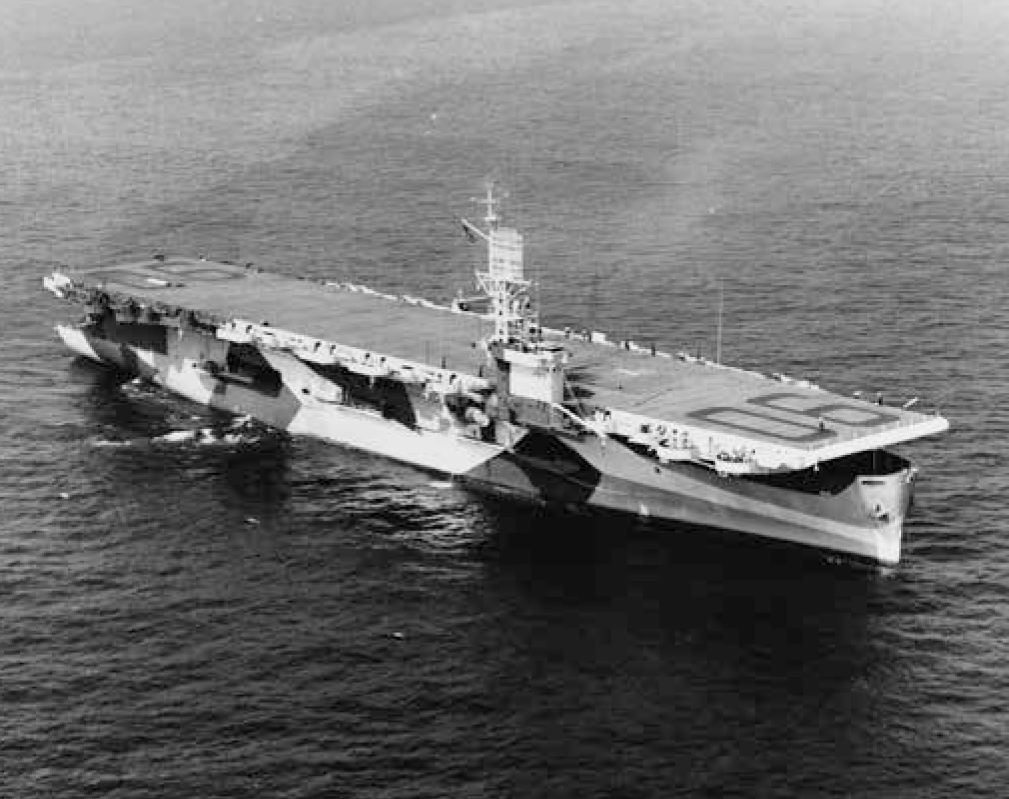
USS Thetis Bay (LPH 6), the first Marine Corps landing platform, helicopter. Naval History and Heritage Command, 19-N-69574
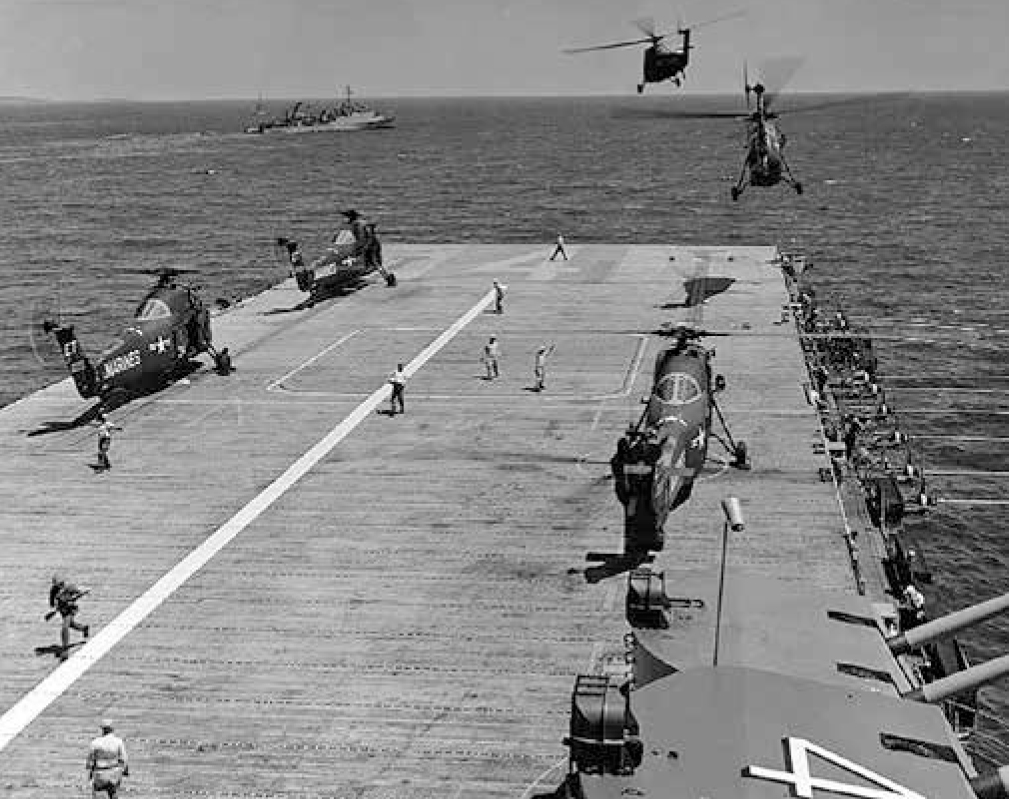
U.S. Marine Corps HUS-1 Seahorse helicopters lift off the USS Boxer’s (LPH 4) flight deck during operations off Vieques Island, Puerto Rico, with the 10th Provisional Marine Brigade on 8 March 1959. Naval History and Heritage Command, NH97288, courtesy of Grantham
According to an article in the Marine Corps Gazette, which represented the unofficial voice of the Marine Corps’ leadership, the FAF consisted of an afloat-ready battalion, a composite helicopter squadron, and a small logistics element embarked aboard the ships of a Navy amphibious squadron, consisting of fast amphibious ships (including an LPH) capable of steaming at 20 knots that would allow them to avoid slower Soviet submarines. The concept stressed that both the Marine and Navy elements of the FAF must train and operate in concert with one another to boost proficiency and overall effectiveness. Although the FAF concept was intended to be implemented in both Pacific (with the Seventh) and Atlantic (with the Sixth) Fleets, it only seems to have been put into effect under that title in the Atlantic.32
The Fleets Experiment with New Concepts
As the outlines of future amphibious doctrine began to take hold, the concepts for Marine Expeditionary Unit (MEU), Marine Expeditionary Brigade (MEB), Marine Expeditionary Force (MEF), and Marine Expeditionary Corps (MEC) had become common usage within the Marine Corps by 1960, though they had not yet been encapsulated in doctrine.33 This led to misunderstandings throughout the Marine Corps regarding their exact usage and composition, whether it applied to the NELM Battalion (redesignated in 1960 as the Landing Force, Mediterranean, or LanForMed) or the FAF.
For example, the 24th MEU (the first recorded use of that designation) was activated at Cherry Point, North Carolina, on 15 November 1960. It consisted of a brigade headquarters, a battalion landing team from the 2d Marine Division, and a provisional Marine aviation group consisting of a light helicopter transport squadron and an ordnance-laden attack or jet fighter squadron embarked separately on an aircraft carrier with the Sixth Fleet.34 Technically speaking, it was a MAGTF, but not quite like the MEU as they are known today, and it did not deploy to the Mediterranean for LanForMed Battalion duty, but deployed only for a series of training exercises. One possible reason is that the Sixth Fleet did not perceive the FAF as a permanent organization; its primary purpose appears to have been to serve as a means to train and familiarize Marines with the emerging doctrinal concepts.
The Sixth Fleet’s FAF went through a number of permutations over the next several years, as different units rotated in and out within its structure, but the FAF itself, which at one point included the pro-visional 16th MEB, never existed for more than three months at a time.35 By the time the Vietnam War began in 1965, it appears to have disappeared altogether, as the demands for ships and battalion landing teams outweighed all other considerations, though the Lan-ForMed Battalion deployments appear to have continued unabated throughout the 1960s.
The introduction of the FAF concept evolved along similar lines with the Seventh Fleet during the early 1960s, but with some typical differences in the operational style between the Atlantic and Pacific Fleets. In 1961, the Seventh Fleet, under the guidance of its commander, Admiral Harry D. Felt, designated its FAF equivalent as the Amphibious Ready Group or ARG. Felt, with Marine Corps support, first proposed the organization of such task forces to Chief of Naval Operations Admiral Arleigh A. Burke, who concurred. This force, the Navy and Marine Corps’ first ARG, was designated Task Force 76.5 and based out of the U.S. Naval Base Subic Bay in the Philippines.36 The prototype ARG consisted of an amphibious squadron with three to four “fast” ships (one LPH, one LSD, and/or an attack cargo ship or AKA) and a Special Landing Force (SLF) instead of a MEU, consisting of a battalion landing team from the 3d Marine Division based in Okinawa and a composite helicopter squadron that included both utility and heavy-lift aircraft. Thus combined, the ARG/SLF would rotate its embarked Marine units every six months, remaining at sea “on station” in support of various Southeast Asia contingencies involving Laos, Cambodia, Thailand, and Vietnam between 1960 and 1964, but was not deployed ashore. That would change during the summer of 1965, when the United States stepped up its involvement in South Vietnam.37
The first MAGTF to sail the Atlantic with its own aviation element was built around battalion landing teams from 3d Battalion, 8th Marine Regiment, and 1st Battalion, 6th Marine Regiment, in February 1961 and included aviation elements from the 2d Marine Aircraft Wing. With an 83-man headquarters element provided by 2d Marine Division, this force was designated as 4th MEB. It was joined shortly thereafter by the 24th MEU, which was already at sea sailing as part of the aforementioned FAF. Combined, the 4th MEB included the USS Boxer and the fast attack transports from the Navy’s Amphibious Squadrons 2 and 8.38
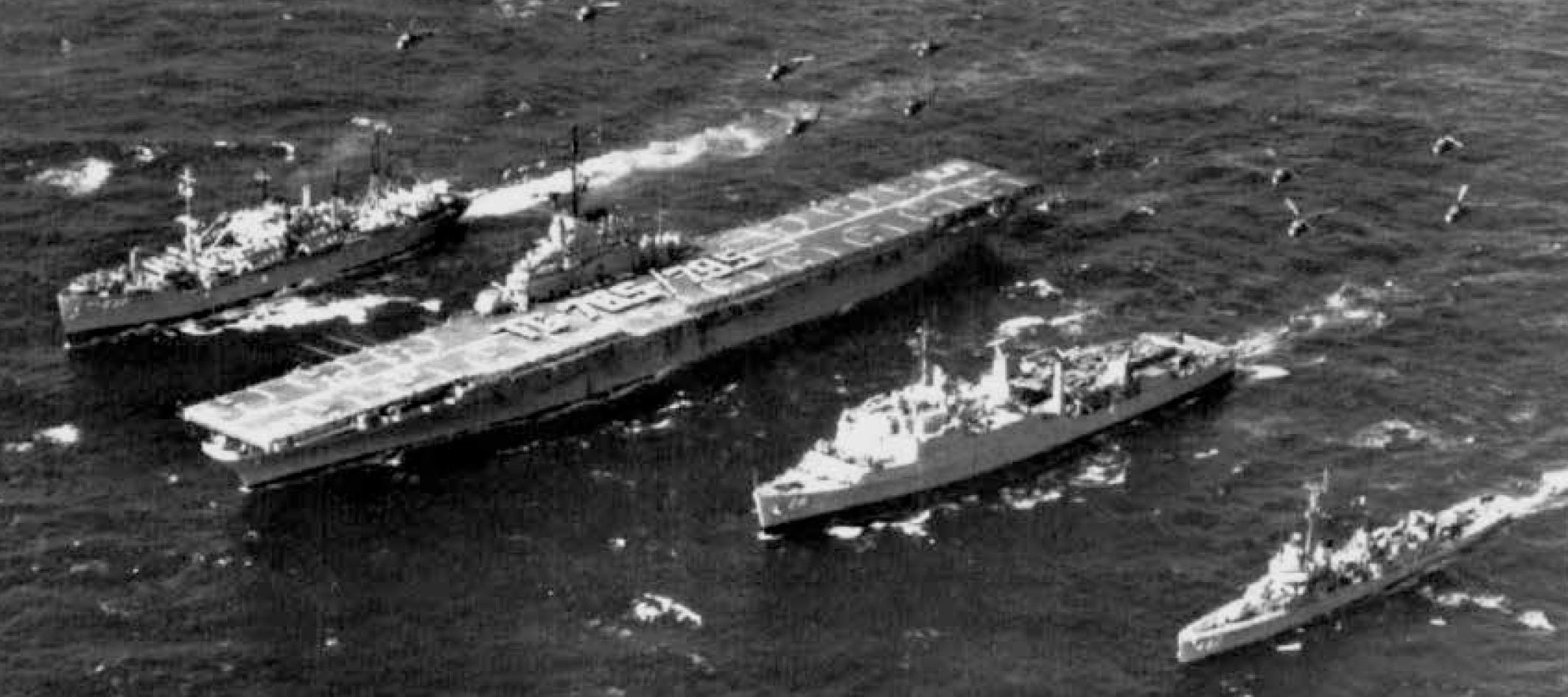
U.S. Navy Seventh Fleet Amphibious Ready Group underway in March 1965 (from left): USS Bexar (APA 237), USS Princeton (LPH 5), USS Thomaston (LSD 28), and USS O’Bannon (DD 450). Sikorsky UH-34D Seahorse helicopters of HMM-365 fly above the ships while Princeton’s crew spells out the task group designations, “TG 76.5/79.5,” on the flight deck. Official U.S. Navy photo, 1142349
This was the first time that a balanced, self-contained, brigade-size MAGTF had participated in a routine afloat mission in the Atlantic and Caribbean. It had not been activated for any specifically designated contingency, such as those brigade-size task forces that had been quickly created or stood up for the Lebanon or Cyprus crises. Instead, like the FAF before it, the MEB served as an enormous sea-going laboratory for amphibious warfare. Though much larger than a MEU, the 4th MEB allowed the Marine Corps to experiment with both its new ships and doctrinal concepts during Exercise LantPhibEx 1-61 before the brigade was deactivated after three months at sea.
A cursory examination reveals that both the Pacific and Atlantic Fleets composited or assembled their afloat-ready forces differently. Those activated for service in the Atlantic, the Caribbean, or in the Mediterranean as LanForMed, tended to be somewhat larger than the special landing force in the Pacific, usually approaching a Marine Expeditionary Brigade (as shown above in the case of the 4th MEB) in size versus that of a battalion landing team-size Marine Expeditionary Unit. Thus, even as late as 1962, it appears that the Marine Corps had still not completely settled the argument about what exactly a MAGTF or a MEU was and what were its constituent elements.
Marine Corps Order Settles the Doctrine Debate
While the evidence indicates that nearly every senior-level Marine (e.g., lieutenant colonel and above) were in general agreement about the overall MAGTF concept, opinions differed widely as to their size, mission, composition, and other important topics. On 27 December 1962, the MAGTF debate was settled once and for all when Marine Corps Order (MCO) 3120.3 was issued by Headquarters Marine Corps after extensive consultation with the Navy, which, after all, would be providing the amphibious warfare ships to carry them. This order, signed by Commandant of the Marine Corps General David M. Shoup, formally codified a MAGTF’s composition in doctrine and specifically enumerated the four types of MAGTFs based on the size of the command.39
The order stated that a MAGTF, regardless of size, would henceforth consist of a ground combat element (GCE), a command element (CE), an aviation combat element (ACE), and a combat service support element or CSSE (now called logistics combat element, or LCE). Additionally, the order specified that a MEU would be based on a battalion landing team, just as the first battalion landing team had been in 1898, and would be augmented by a composite helicopter squadron and a dedicated logistics battalion. Though the doctrine was quickly accepted and the terminology agreed upon, the Seventh Fleet, demonstrating its independent streak, continued to use the term special landing force for the MEU sailing with the ARG in the Pacific.40
In line with the declaration laying out the composition of a MEU, the order further stated that a MEB was to be based on a reinforced regimental combat team, a composite air group, and a logistics regiment. The MEF would be based on a Marine division, air wing, and appropriately sized logistics elements. The MEC, though the term was never used in practice due to the U.S. Army’s objections, was to be based on two or more Marine divisions, with an appropriately sized air wing and logistics element. In practice, however, the MEF has effectively functioned as a corps-size headquarters, demonstrated by the performance of I MEF during Operation Desert Storm in 1991 and during Operation Iraqi Freedom in 2003.
The Marine Corps Internalizes the Concept
Simply stating “Let there be MEUs, MEBs, MEFs, and MECs” was not the same as creating these organizations. A great deal of learning had to be accomplished and many different subordinate doctrinal publications, tables of organization, tables of equipment, and reams of Service regulations had to be written. The best way to try out new doctrine was through actual practice using real Marines and real ships, where lessons could be learned and modifications made. New organizations had to be created out of thin air, so to speak, since they may not have existed before or even been contemplated in the original 1961 order.
For instance, MEU headquarters generally did not exist in the early 1960s. The usual practice was to take a Marine division or regimental headquarters and either increase its capability with more staff and equipment to make a MEU headquarters or strip down a division headquarters to the bare essentials to create a MEB headquarters. For a more permanent solution, MEU headquarters had to be designed and built into future budgets so the manpower spaces could be allocated, equipment purchased, and funding for training programmed.
An excellent example of how each MEF worked through the task of incorporating the new doctrine can be seen in how the Pacific Fleet’s SLF evolved. The first SLF created in 1960 lacked a separate command element. Instead, the commander of the battalion landing team or the commander of the helicopter squadron, depending on which was senior, served in a dual capacity as both battalion commander and SLF commander. With the addition of an aviation element consisting of a mixed rotary-wing squadron, this quickly proved to be an unworkable arrangement, since the battalion landing team commander lacked the expertise and communications means to com- mand and control it. Consequently, III MEF in Okinawa authorized the activation of a small permanent SLF command element in 1965.41 A year later, this staff had evolved into a true MAGTF headquarters approximately the size and capability of an infantry regiment’s staff.42
As the demand for more troops to support the Marines in Vietnam increased, the ARG/SLF was increasingly employed ashore, where it took part in numerous ground combat operations, so much so that the Navy decided it needed another ARG/SLF activated just to ensure that the Seventh Fleet still had a reserve landing capability should other emergencies arise in the Pacific Rim not involving Vietnam. Accordingly, a second ARG/SLF, or ARG-B, was created to complement the original ARG, now designated ARG-A. From 1965 to 1969, both ARGs rotated be- tween service with the fleet and ashore in support of III MAF in South Vietnam. During this period, both ARGs carried out 62 amphibious landing operations in Vietnam while taking part in dozens of cruises with Seventh Fleet.43
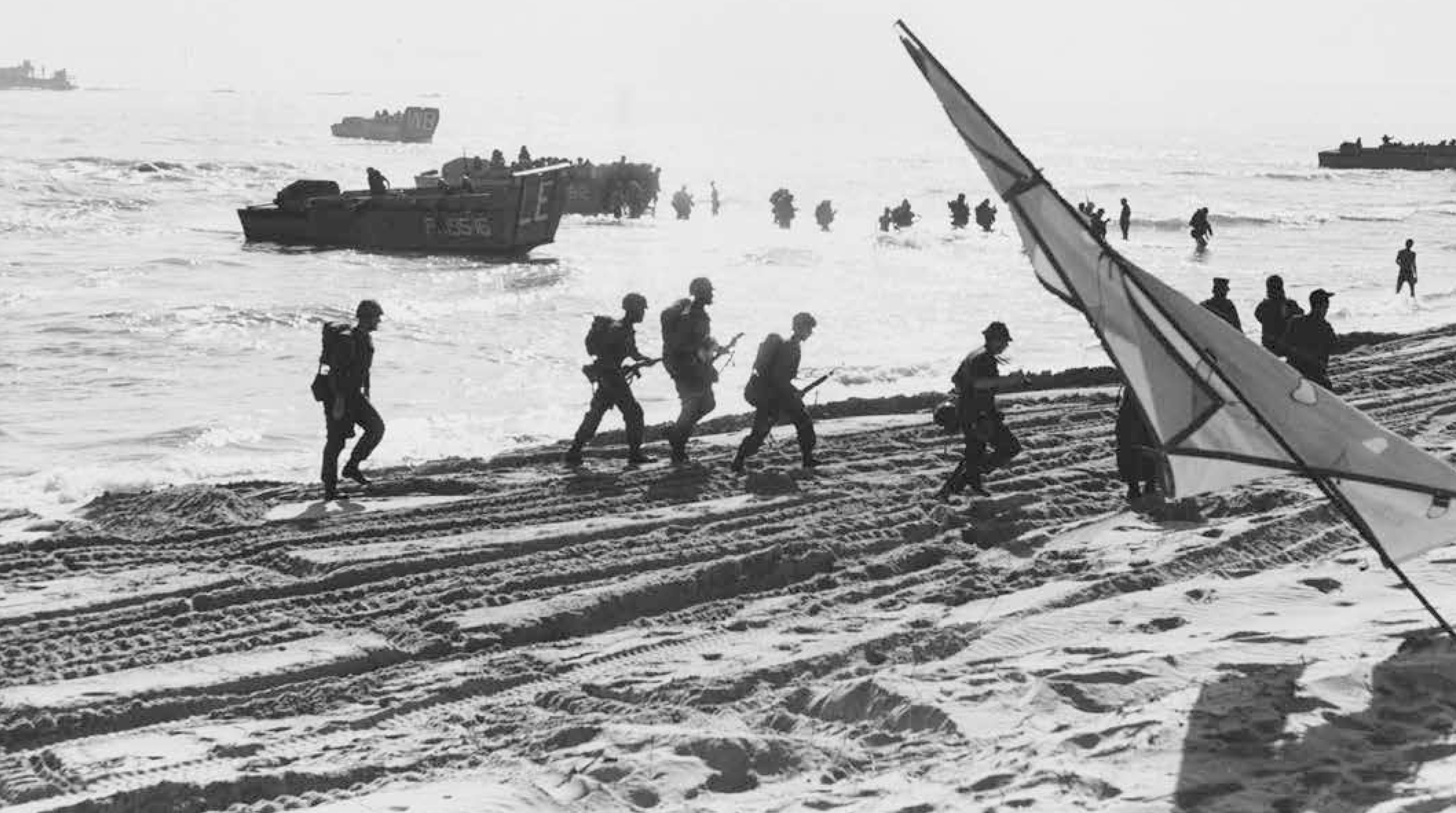
Marines from the Pacific Fleet’s Amphibious Ready Group/Special Landing Force wade ashore near Da Nang, Republic of Vietnam, ca. 1965. Defense Department (U.S. Navy) 1110983
The only change that occurred during this period worth noting involved the renaming of Marine Expeditionary Units, which, due to perceived South Vietnamese sensitivity to the term expeditionary (with the attendant negative connotations of French Colonial rule), were redesignated as Marine Amphibious Units or MAUs in 1965. Between 1965 and 1990, a variety of former MEUs carried over this term until all existing MAUs reverted to their former naming convention of MEU. Except for the name change, everything else remained the same. Finally, even the Seventh Fleet’s special landing force was redesignated as a MAU in 1969, then once again as a MEU by 1988.44
U.S. Navy Support to the ARG/MEU Concept
The final piece of the afloat-ready battalion concept involved related activities of the U.S. Navy, which had continuously coordinated its ship design initiative with the Marine Corps. While the ARG/MEU concept had become embedded in Navy practice, if not in doctrine, purpose-built ships to replace the World War II-vintage ships did not arrive in the fleet until 26 August 1961, when the first LPH was built as such from the keel up, and the USS Iwo Jima (LPH 2) was commissioned. Six others of its class soon followed. These ships were capable of carrying 26 helicopters and nearly 2,000 Marines of a reinforced battalion landing team, equating to 193 officers and 1,806 men.45
However, as impressive as these vessels were in terms of their vertical envelopment capability, they lacked a well deck, thus forcing the ARG/MEU to rely on older LSTs and LSDs to carry the ship-to-shore “connectors” (LVTs, LCVPs, LCUs, etc.) for over-the-beach amphibious capability. Fortunately, by 1962, a new type of amphibious warship, the landing platform, dock or LPD (known today as amphibious transport docks), entered service, easing the reliance on the World War II-era vessels. It had both a well deck and purpose-built helicopter landing platforms, giving it a versatility that the older ships lacked.
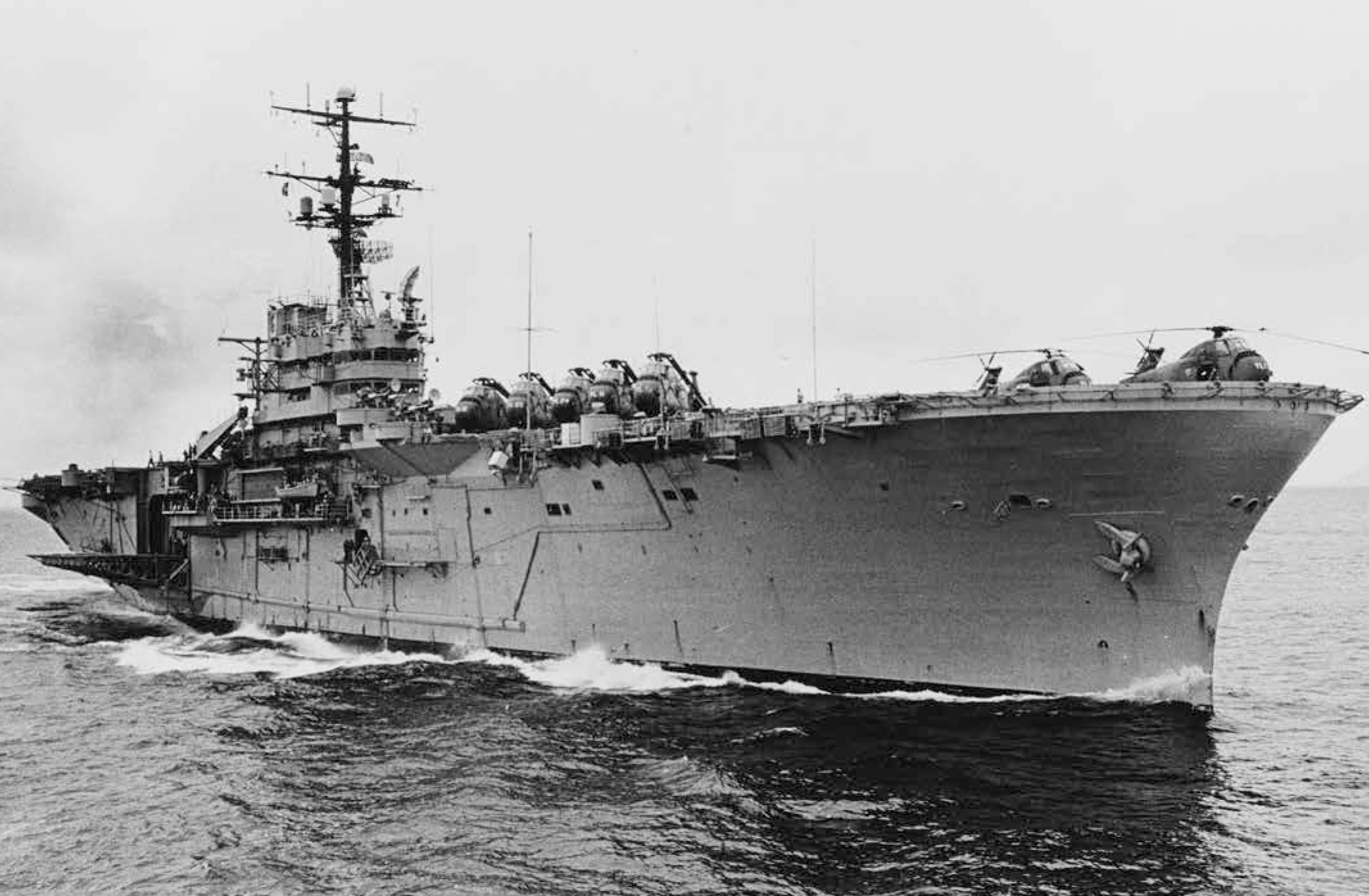
USS Okinawa (LPH 3) underway in the South China Sea in January 1969 with several CH-34 Seahorse helicopters parked on her flight deck. Naval History and Heritage Command, NH107670, courtesy of PHC A. L. Smith
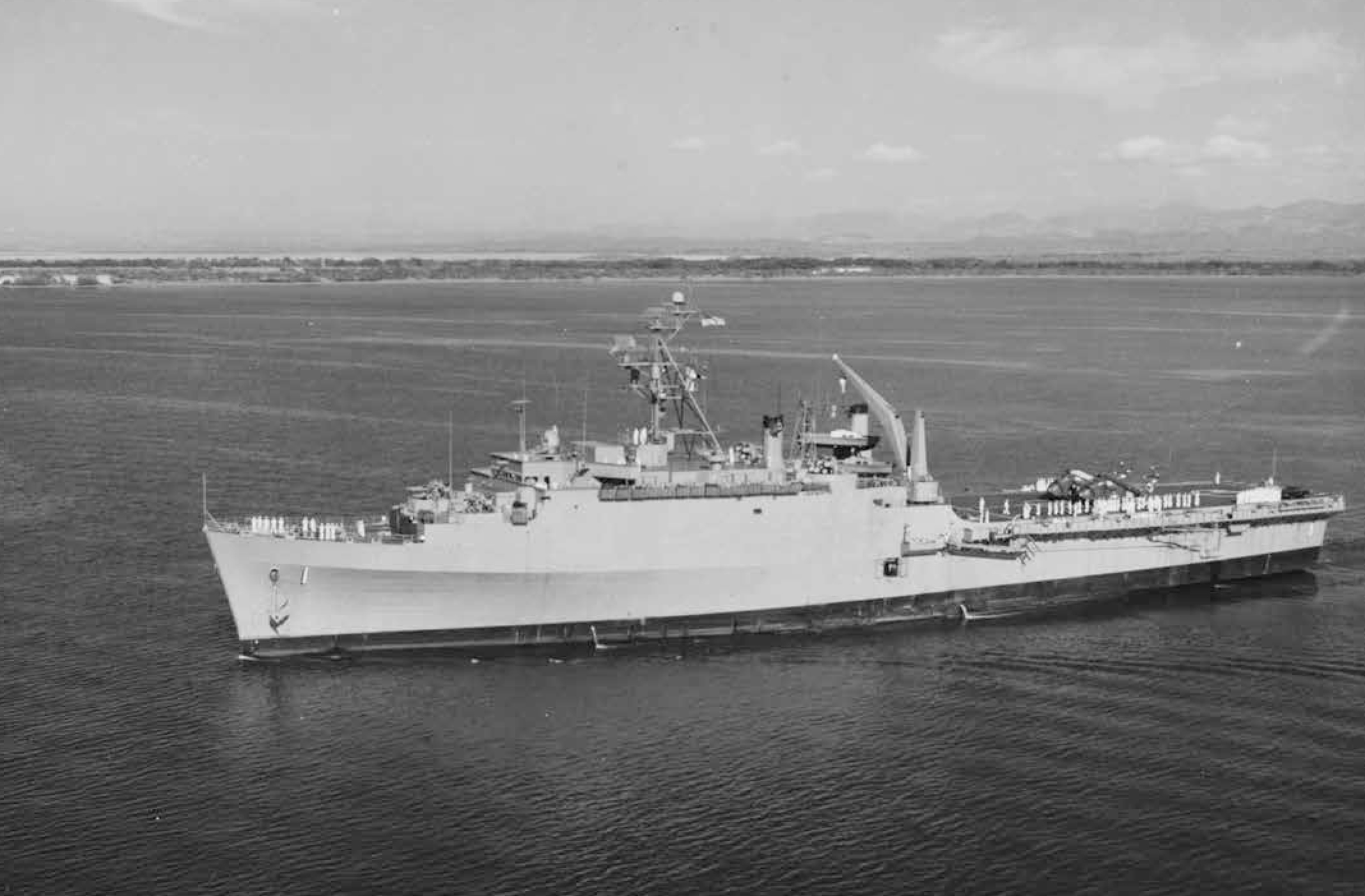
USS Raleigh (LPD 1) underway at Guantánamo Bay, Cuba, on 1 February 1963. The ship carries two CH-34 Seahorse helicopters parked on her afterdeck. Naval History and Heritage Command, NH107694, courtesy of PH3 Houchins
By 1970, composition of ARGs, at least as far as the Navy was concerned, had become a settled issue due to the retirement of the rest of the few remaining World War II-era amphibious ships and the construction of enough new ones to replace them. The “standardized” ARG/MEU was now composed of an amphibious squadron (PhibRon) consisting of one LPH (later replaced by the amphibious assault ship, general purpose, or LHA), one LPD, and one LSD combined with a MEU of 2,200 Marines. However, fixed-wing aircraft were still embarked aboard Navy fleet carriers, which were not part of the ARG/MEU combination. War plans directed that, once a beachhead had been taken, airstrips would then be seized or constructed, allowing fixed-wing aircraft to land, where they would then revert to ARG/MEU control. This unsatisfactory situation would not change until 1979. The slower Newport-class LSTs and attack cargo ships, or AKAs, were relegated to other amphibious squadrons before they were phased out entirely by 2000, being superseded by the new classes of ships being commissioned. Attack transports (APAs), the last vestige of the World War II-type attack transport, also were completely phased out by 1980. Though the ARG/MEU composition had been settled for nearly 40 years, it was not until 2010 that it was finally codified in the U.S. Navy’s Operational Instruction OPNAV 3501.316B on 21 October.46
Evolution into Today’s ARG/MEU
The last significant development occurred on 29 May 1976, when the first Tarawa-class LHA was commissioned. The USS Tarawa (LHA 1) was the first LHA with a well deck for carrying and launching landing craft, utility (LCU), amphibious assault vehicles- personnel 7 (AAV-P7), and landing craft, air cushion (LCAC). There were five of these enormous ships built, each capable of carrying as many as 41 helicopters or a balanced mix of Boeing Vertol CH-46 Sea Knights, Sikorsky CH-53 Sea Stallions, Bell AH-1W Super Cobras, and Bell UH-1 Iroquois, as well as 1,903 troops.47 The USS Tarawa deployed on its first Western Pacific cruise in March 1979 and, for the first time, operated with a McDonnell Douglas AV-8B Harrier vertical short takeoff and landing (VSTOL) jet squadron, in addition to an embarked helicopter squadron in a successful experiment to determine the feasibility of VSTOL aircraft operating from an LHA.
With the addition of the AV-8B Harrier, the ARG/MEU combination finally had its own organic fixed-wing aircraft squadron, capable of providing combat air patrol coverage as well as close air support to the MEU. Today, ARG/MEUs often deploy as part of an Expeditionary Strike Group (ESG) consisting of an aircraft carrier or other surface warfare combatants. Since 2015, the more-capable USS Wasp-class LHDs and the new USS America-class LHAs have completely replaced the Tarawa-class LHAs. Both classes of ships now operate with the new Bell Boeing MV-22 Osprey and will soon host the newly introduced Lockheed Martin F-35 Lightning II VSTOL aircraft, which is replacing the AV-8B. One thing has not changed, however. Conventional Marine fixed-wing aviation assets, such as the McDonnell Douglas F/A-18 Hornet, still operate from the decks of Navy fleet carriers. Once suitable airfields are constructed ashore, they will deploy as part of the ARG/MEU, though the Naval Task Group commander still retains the option of having them operate under his control.
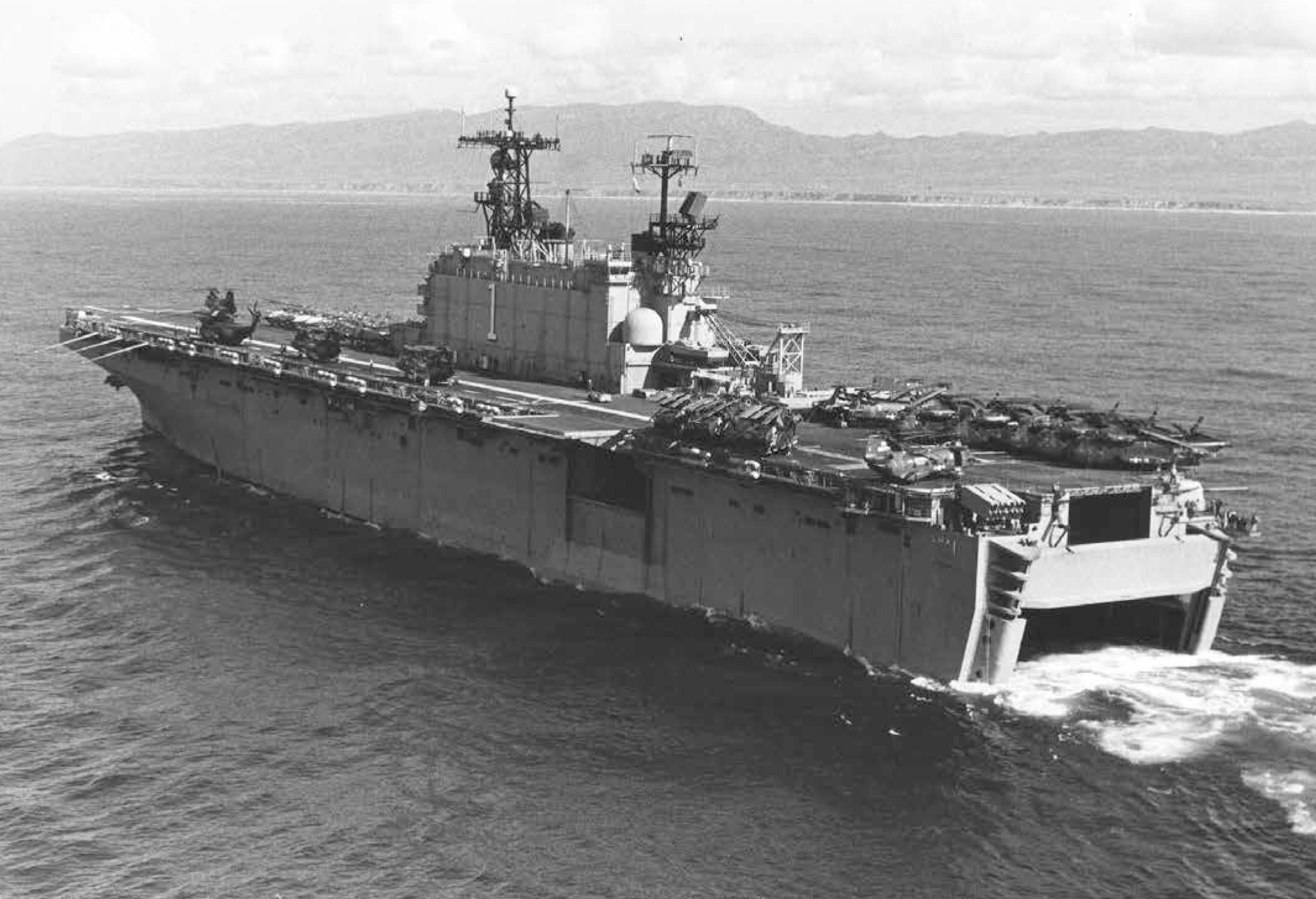
USS Tarawa (LHA 1) underway in the Pacific Ocean in March 1979. Note the light-colored Douglas A-4 Skyhawk parked between two AV-8 Harriers on the ship’s starboard after flight deck. Naval History and Heritage Command, NH107654
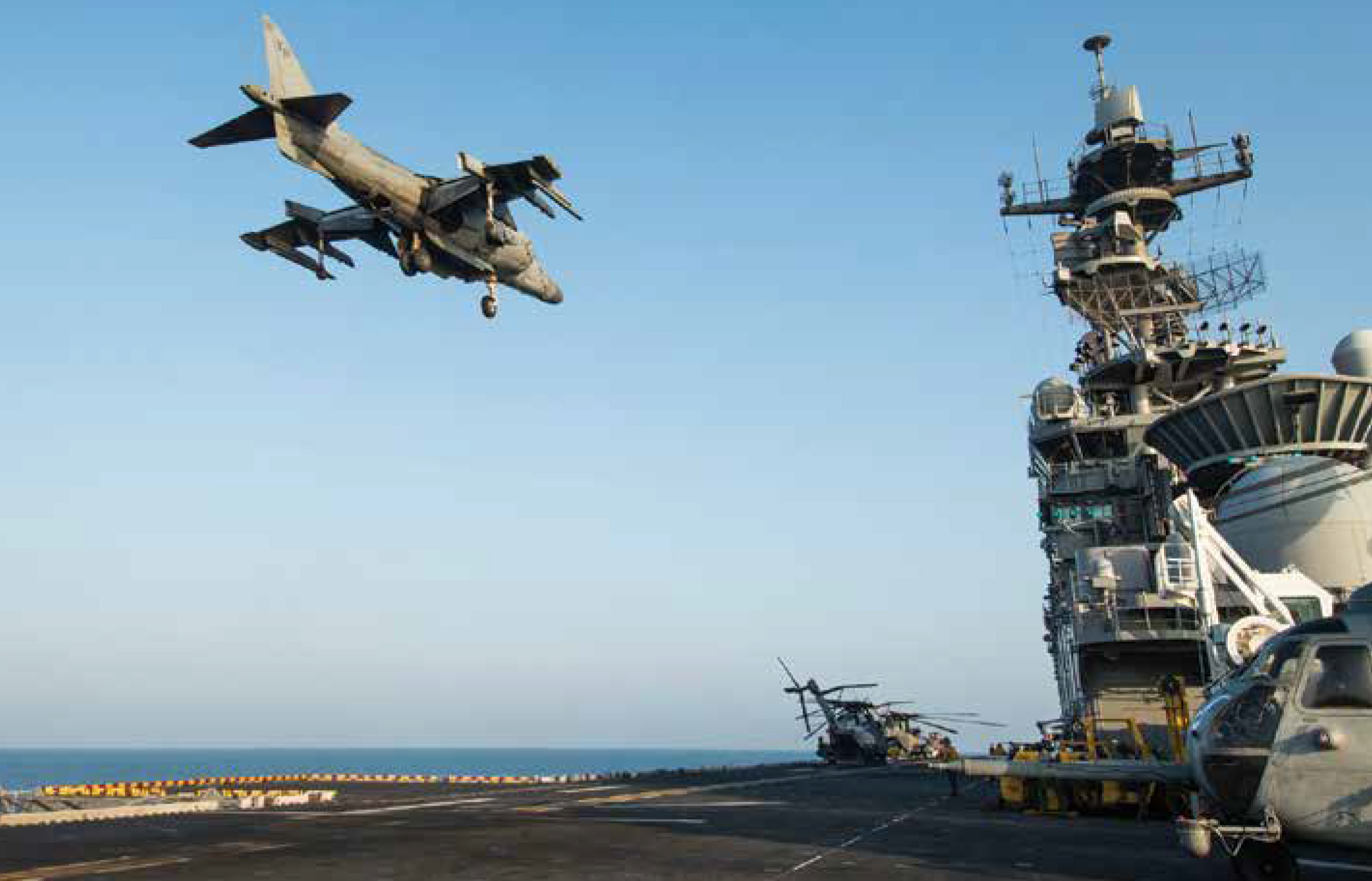
An AV-8B Harrier, assigned to Marine Medium Tiltrotor Squadron 163 (VMM-163) (Rein), hovers above the flight deck during a vertical takeoff from the amphibious assault ship USS Makin Island (LHD 8) on 23 August 2016. As the flagship of the Makin Island ARG, the ship is deployed with the embarked 11th MEU to support maritime security operations and theater security cooperation efforts in the U.S. Navy’s Fifth Fleet area of operations. Official U.S. Navy photo, courtesy of PO3 Devin M. Langer
Introduction of the MEU (Special Operations Capable) Concept
Another change to the ARG/MEU concept occurred in December 1985, when the 26th MAU (redesignated as a MEU in 1988) received the special operations capable, or SOC, designation, becoming the 26th MAU (SOC). Though the actual organization of the MAU itself did not change, its mission profile did, based upon an increasing awareness within the Department of Defense that the growth of terrorism around the world required an effective military response that went beyond traditional capabilities, bordering on those ordinarily possessed by special operations forces (SOF). The addition of a SOC designation to its title signified that a MAU had been issued certain equipment “enhancements” and had trained to a rigid standard prior to deploying. Once it had arrived on station, a MAU (SOC) might be called upon to accomplish special operations-like missions, such as in extremis hostage rescue or noncombatant rescue operations and antiterrorist operations.48 By 1987, all deploying MAUs were required to train to MAU (SOC) status.
Marine Amphibious Units from that point onward would only receive the MAU (SOC) designation prior to deployment after they had met special operations certification requirements; otherwise, when not deployed, they would retain the normal MAU title (in 1988, they were once again redesignated MEUs and became MEU [SOCs]). This concept remained in effect from 1985 until 2005, when the newly activated special operations companies of Marine Corps Special Operations Command (MARSOC) began to assume the mission and MEUs finally dropped the SOC appellation.49 Currently, MEUs can only use the SOC designation if a Marine Corps special operations component is attached to carry out specific special operations-related missions, though in practice this rarely occurs due to the high demand for their services within the U.S. Special Operations Command.
Conclusion
While current operational concepts, such as a disaggregated or split-based ARG/MEU, have recently been put into practice, the core concept of the ARG/ MEU remains unchanged and will probably stay that way for the foreseeable future. As this article has shown, during the past 118 years, a progression of changes in national security policy, Service doctrine, and technology have combined to provide today’s afloat-ready force the capability that Lieutenant Colonel Huntington could only dream about. Though the modern expeditionary amphibious force, with its war- ships, aircraft, and landing craft, is far removed from the afloat-ready battalion that saw its debut during the Spanish-American War, the concept itself—that of having an embarked self-sustaining battalion-size force ready to be landed anytime, anywhere at the order of the U.S. government—has hardly changed at all. Though debate may swirl around the notion that amphibious warfare has become obsolete, one thing is certain—as long as there is a U.S. Marine Corps, there will be an ARG/MEU at sea somewhere, ready for the call to carry out the nation’s bidding.
• 1775 •
Endnotes
*Douglas E. Nash Sr. was born in Charlotte, NC, and grew up in an Air Force family. He enlisted in the U.S. Army in 1974 and graduated from the U.S. Military Academy at West Point in 1980. After 32 years of service in a variety of armor, cavalry, and special operations assignments, he retired at the Pentagon in 2006. He has masters degrees in international relations and in military history and has authored several books, including Hell’s Gate: The Battle of the Cherkassy Pocket, January to February 1944 (2002) and Victory Was Beyond Their Grasp: With the 272nd Volks- Grenadier Division from the Hürtgen Forest to the Heart of the Reich (2008), which was nominated for the 2008 Pulitzer Prize for non-fiction. He is currently serving as the senior historian for Marine Corps History Division.
- Naval Operations Concept 2010: Implementing the Maritime Strategy (Washington, DC: Department of the Navy, 2010), 51.
- Amphibious Ready Group and Marine Expeditionary Unit: Overview (Washington, DC: Headquarters Marine Corps, 2013), 1.
- Bowman H. McCalla, Report of Commander McCalla upon the Naval Expedition to the Isthmus of Panama, April 1885 (Washington, DC: Navy Department, 1885), 43–81.
- John J. Reber, “Huntington’s Battalion Was the Forerunner of Today’s FMF,” Marine Corps Gazette 63, no. 11 (November 1979).
- Incidentally, the same bay is still in use by the U.S. Navy 118 years later.
- Surprisingly, 98 percent of the men had been unaffected by any tropical disease, compared to the Army contingent in the Cuban campaign, which suffered inordinately from such diseases as yel- low fever. Their good fortune was attributed to the fact that, for most of the campaign, the Marines had been embarked aboard a ship away from the swampy lowlands, and while they were ashore had practiced rigorous field sanitation procedures.
- The origination of military parades harkens back to military formations during close-order maneuvers. More recently, the actions became strictly ceremonial in nature, particularly during the nineteenth and twentieth centuries when military units were returning from deployments or as a means to demonstrate the military might of a nation.
- Allan R. Millett and Jack Shulimson, Commandants of the Marine Corps (Annapolis: U.S. Naval Institute Press, 2004), 140.
- Ibid.
- At the time, an advanced base force was understood to be a coastal or naval base defense force designed to establish mobile and fixed bases in the event major landing operations would be necessary beyond U.S. shores.
- James D. Hittle, “Sea Power and the Balanced Fleet,” Marine Corps Gazette 32, no. 2 (February 1948): 57.
- Millett and Shulimson, Commandants of the Marine Corps, 141.
- Spencer C. Tucker, Almanac of American Military History: 1000– 1830, vol. 1 (Santa Barbara: ABC-CLIO, 2012), 1210.
- Ibid., 1213.
- Kenneth W. Condit, History of the Joint Chiefs of Staff: The Joint Chiefs of Staff and National Policy, 1947–1949, vol. 2 (Washington, DC: Office of Joint History, Office of the Chairman of the Joint Chiefs of Staff, 1996), 6.
- Allan K. Henrikson, “The Creation of the North Atlantic Alliance: 1948–1952,” Naval War College Review 32, no. 3 (May/June 1980): 12. Editor’s note: the May/June 1980 issue of Navy War College Review was published bearing the incorrect volume number (32); the correct volume number for all 1980 issues is 33.
- John G. Norris, “Navy Places Its Top Strategist in Command of Area,” Washington Post, 6 January 1948.
- Ibid.
- Hittle, “Sea Power and the Balanced Fleet,” 59.
- Condit, History of the Joint Chiefs of Staff, 150.
- George F. Kennan, Report by the Policy Planning Staff: Review of Current Trends—U.S. Foreign Policy, Policy Planning Staff Paper no. 23 (Washington, DC: U.S. Department of State, 1948).
- “Marines Are on Their Way,” Sunday Star-News (Wilmington, NC), 13 January 1957, 8-A.
- Lemuel C. Shepherd Jr., The Marine Air-Ground Task Force Concept (Washington, DC: Headquarters Marine Corps, 1954).
- While the development of MAGTF doctrine did have some in- fluence on the continuing evolution of the afloat-ready battalion concept, particularly in regard to the integration of the aviation element, it is a separate concept that evolved along parallel lines and will be covered in greater detail in a future volume of this publication.
- Shepherd, The Marine Air-Ground Task Force Concept, 2.
- Concept of Future Amphibious Operations, LFB-17 (Washington, DC: Headquarters Marine Corps, 1955).
- Ralph W. Donnelly, Gabrielle M. Neufeld, and Carolyn A. Tyson, A Chronology of the United States Marine Corps, 1947–1964, vol. III, Marine Corps Historical Reference Pamphlet (Washington, DC: Historical Division, Headquarters Marine Corps, 1971), 34.
- Ibid., 36.
- “’Copter Carrier Commissioned,” Naval Aviation News, September 1956; and “Fuji Feels Marine Assault,” Naval Aviation News, December 1957, 36.
- Like many of the ships from this period, the Boxer saw a great deal of change during its service. Originally classified as an aircraft carrier (CV 21) in 1945, it was repeatedly reclassified, first as an attack carrier (CVA 21) then as an antisubmarine carrier (CVS 21).
- LtCol Eugene W. Rawlins, Marines and Helicopters, 1946–1962, ed. Maj William J. Sambito (Washington, DC: History and Museums Division, Headquarters Marine Corps, 1976), 87–88.
- R. A. Stephens, “Fast Amphibious Force,” Marine Corps Gazette 45, no. 1 (January 1961): 46–47.
- “Fleet Marine Force,” Marine Corps Gazette 44, no. 7 (July 1960): A-1.
- Donnelly, Neufeld, and Tyson, A Chronology of the United States Marine Corps, 43.
- “Marine Expeditionary Brigade Returns from Mediterranean Area Maneuvers,” Camp Lejeune Globe, 8 June 1961, 6.
- 36 Edward J. Marolda and Oscar P. Fitzgerald, The United States Navy and the Vietnam Conflict: From Military Assistance to Combat, 1959–1965, vol. II (Washington, DC: Naval Historical Center, De- partment of the Navy, 1986), 42.
- Ibid., 474, 529.
- “Marines at Work: 4th MEB,” Marine Corps Gazette 45, no. 4 (April 1961): 4–5.
- MCO 3120.3, The Organization of Marine Air-Ground Task Forces (Washington, DC: Headquarters Marine Corps, 1962).
- Ibid., enclosures 1–2.
- Jack Shulimson and Maj Charles M. Johnson, U.S. Marines in Vietnam: The Landing and the Buildup, 1965 (Washington, DC: History and Museum Division, Headquarters Marine Corps, 1978), 196, 200–1.
- Jack Shulimson, U.S. Marines in Vietnam: An Expanding War, 1966 (Washington, DC: History and Museum Division, Headquarters Marine Corps, 1982), 297.
- Benis M. Frank and Ralph F. Moody, “SLF Operations in Vietnam” (unpublished paper, History and Museums Division, Head- quarters Marine Corps, 1972), Section VII, 4.
- Jonathan D. Geithner, Historical ARG/MEU Employment (Arlington, VA: CNA, 2015), 3–4; and All Marines Message 023/88, Change of Marine Corps Task Unit Designations (Washington, DC: Headquarters Marine Corps, 5 February 1988).
- “Iwo Jima (LPH-2), 1961–1993,” Naval History and Heritage Command, 10 November 2015, http://www.history.navy.mil/research/histories/ship-histories/danfs/i/iwo-jima.html.
- OPNAV 3501.316B, Policy for Baseline Composition and Basic Mission Capabilities of Major Afloat Navy and Naval Groups (Washing- ton, DC: Department of the Navy, 21 October 2010).
- Amphibious Ships and Landing Craft Data Book, Marine Corps Reference Publication 3-31B (Washington, DC: Headquarters Marine Corps, 2001), 3–5.
- Report of Examination of Marine Corps Special Operations Enhancements (Norfolk, VA: Fleet Marine Force, Atlantic, 1985).
- Frank L. Kalesnik, “MARSOC: U.S. Marine Corps Forces, Spe- cial Operations Command, The First Decade, 2006–2016” (PhD dissertation, MARSOC, 2016), 6–7. According to MCO 3120.9B, the MEU (SOC) was required to demonstrate interoperability with the embarked Naval Special Warfare Task Unit (SEALs) prior to deploying. Other sources suggest that the SEALs stopped deploying with MEUs shortly before 2001.